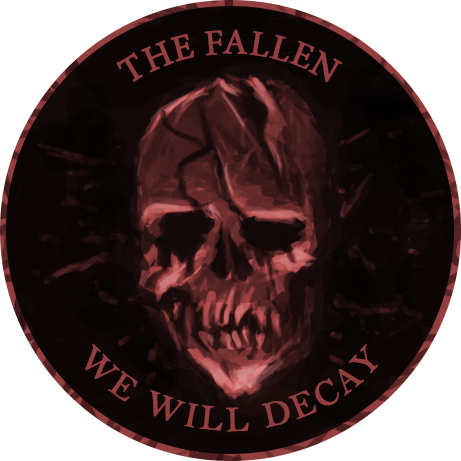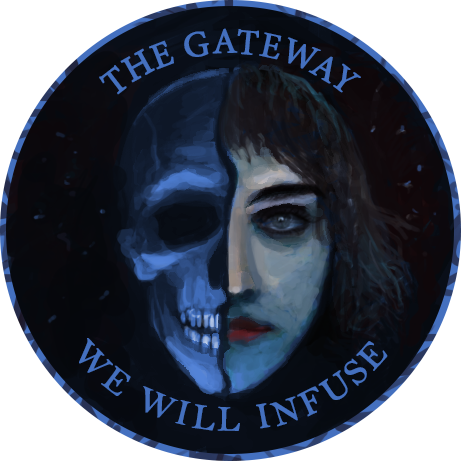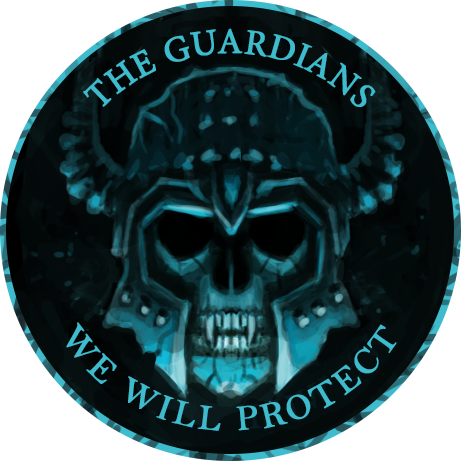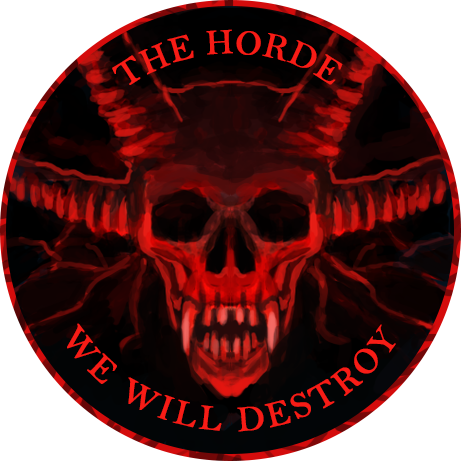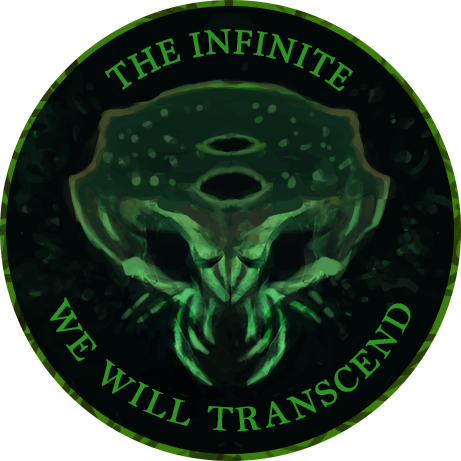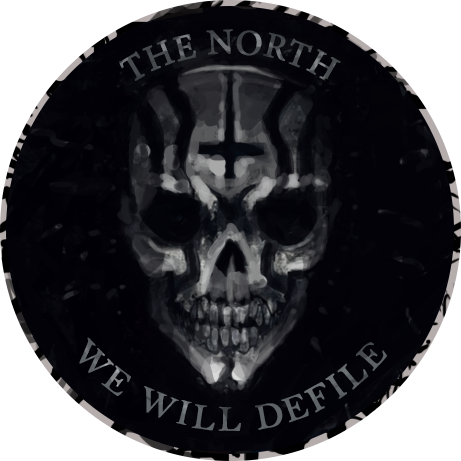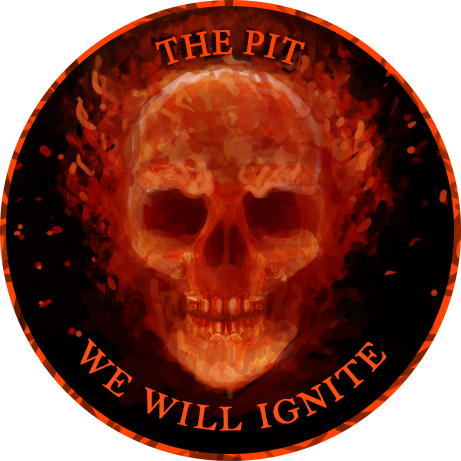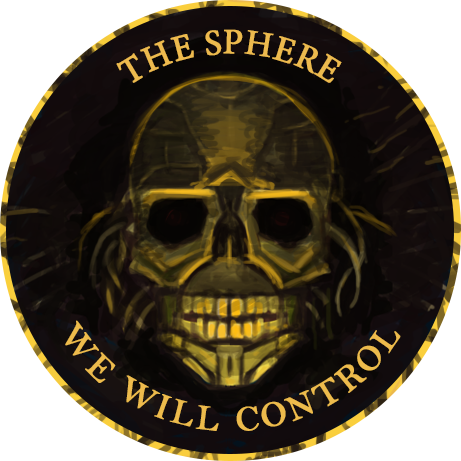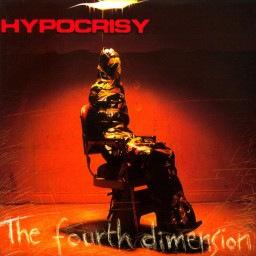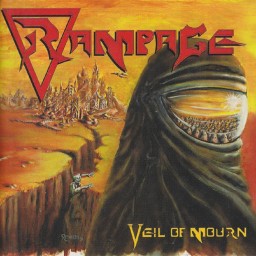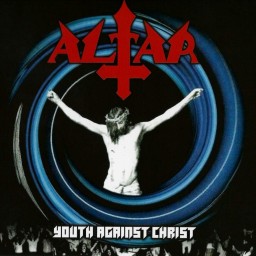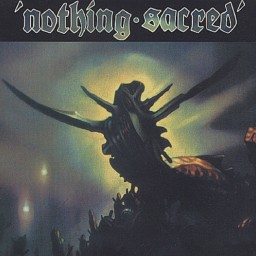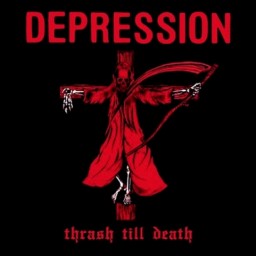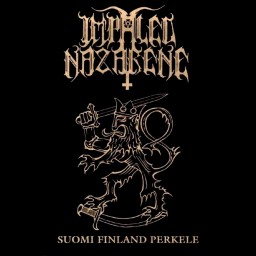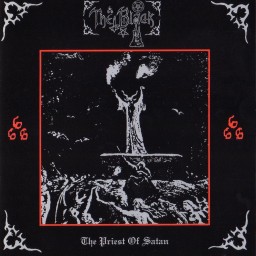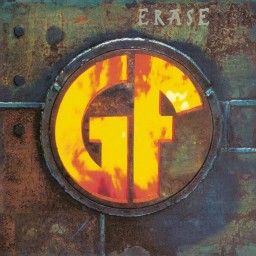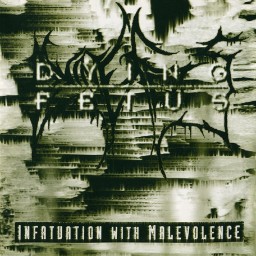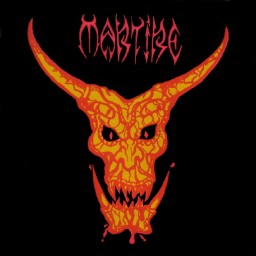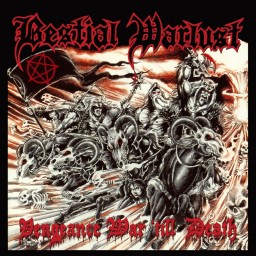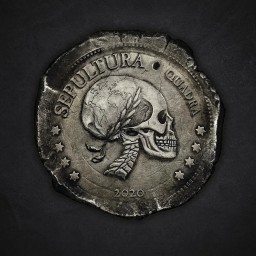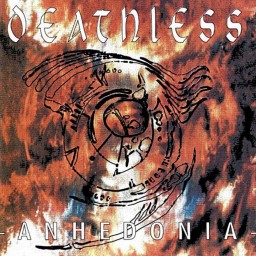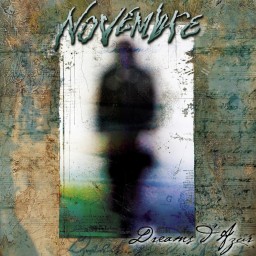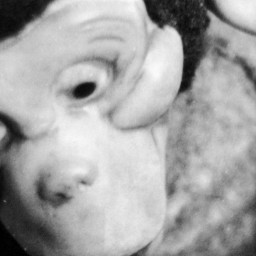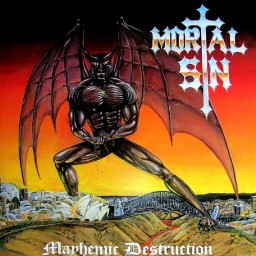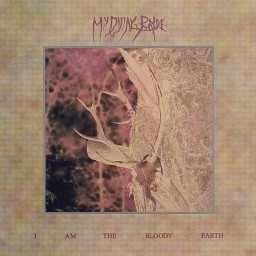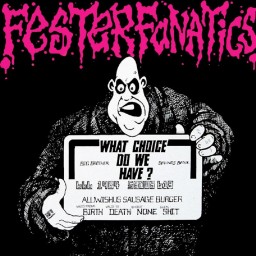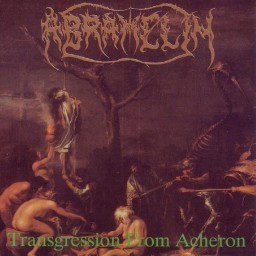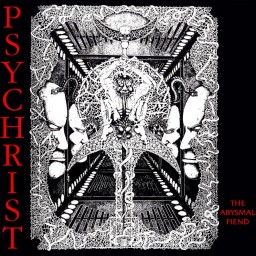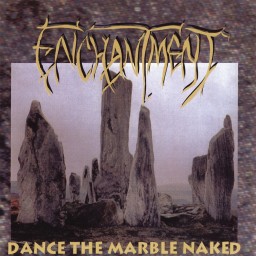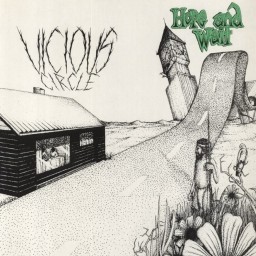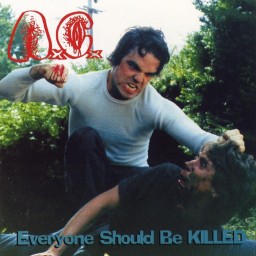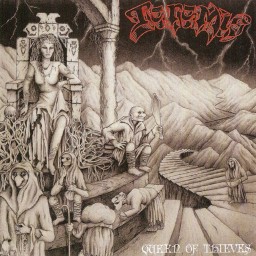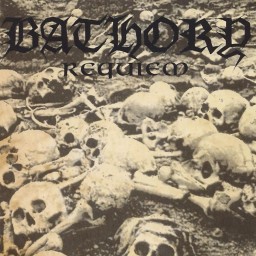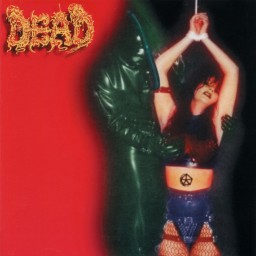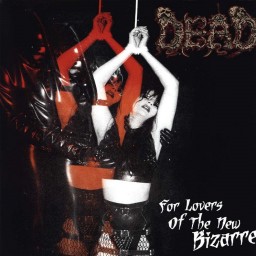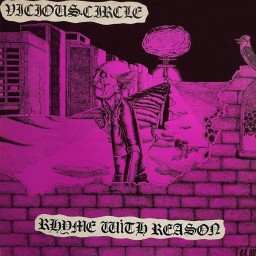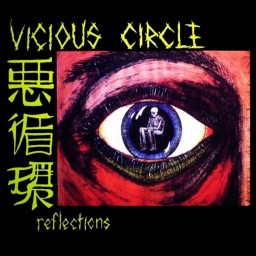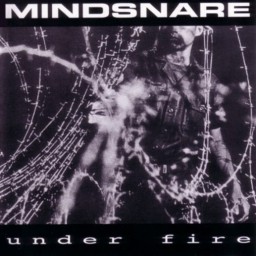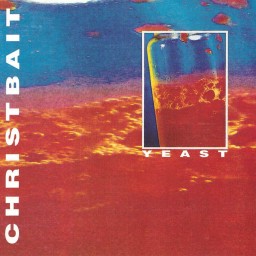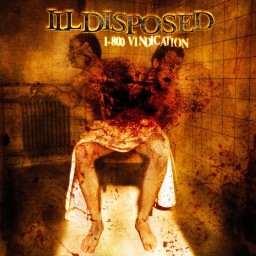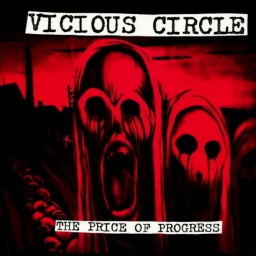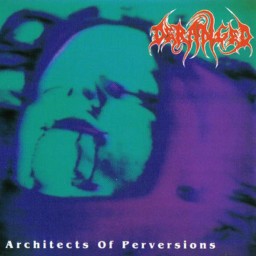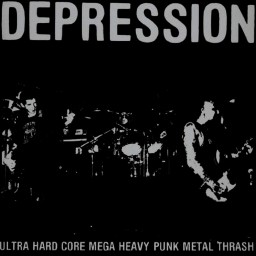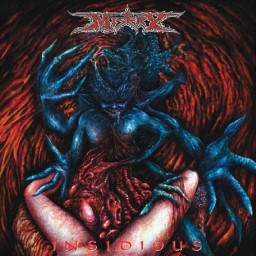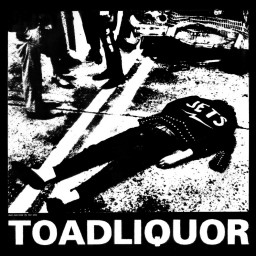Daniel's Reviews
While the early releases from Swedish death metallers Hypocrisy may not have changed my life, they did offer me a fair amount of enjoyment as a young fella during the early 1990's. I'd first discovered them through their 1992 debut album "Penetralia" which Neuropath vocalist Mark Wangmann had brought to my attention shortly after it was released & I'd subsequently followed them through their 1993 sophomore album "Osculum Obscenum" & 1994 "Inferior Devoties" E.P., both of which had performed a similar role in providing a fairly traditional brand of death metal that stayed largely within the limited capabilities of the various band members. "Inferior Devoties" had seen Hypocrisy further reducing their lineup from the five-piece they originally started as though with band leader Peter Tägtgren (Pain/Bloodbath/Lindemann/Lock Up/The Abyss/War) taking over the vocal duties from original front man Masse Broberg (Dark Funeral/Demonoid/Obscurity/Witchery) on top of his existing guitar & keyboard responsibilities which would see Hypocrisy going to market as a trio for the first time. They must have liked the simplicity it provided them with as the Swedes would return with that same lineup for 1994's "The Fourth Dimension" third album, a record that is known as being somewhat of a transitional record for Hypocrisy & one that I remember fairly fondly. A recent read of Ben's review of "The Fourth Dimension" has seen my interest being renewed though as Ben expressed that this record was somewhat of a step up for Tägtgren & co. with the adjustments that had been made to the more traditional Hypocrisy sound being most welcome. Let's see if I feel similarly then, shall we?
"The Fourth Dimension" was recorded & mastered at Park Studio in Stockholm during March & April of 1994 with Tägtgren once again handling the production duties as he had on all of Hypocrisy's previous releases. Those first three records all sound a little different from each other but there seems to be a feeling amongst fans that "The Fourth Dimension" sports a cleaner sound in terms of production. I see things a little differently though & would actually suggest that Hypocrisy's third full-length sounds a little weaker than the Swedes first two records with the murkier guitar tone not really complementing the powerful bottom-end of rhythm section, although it admittedly works better than it might have due to the slower tempo range that Hypocrisy tend to work within compared to their earlier work. Tägtgren had handled the vocals on several tracks from the band's earlier releases so he doesn't sound completely foreign here but I do have to mention that I prefer Broberg's more sinister tone over his deeper & slightly more gutteral growls which don't summon as much darkness & energy as his predecessor.
There's been a lot said about Hypocrisy's transition from a very conventional death metal sound to a far more Swedish melodic death metal one over the years with "The Fourth Dimension" most often described as the link between the two but, while I'm not disputing that theory, I will say that it's a fairly narrow-minded view to claim Hypocrisy's third album as a genuine melodeath release because it's not nearly as simple as that. You see, Hypocrisy tackle a few different sounds across the thirteen-song track-listing with classic death metal, melodeath & a slower doom/death style all receiving a decent airing. The album is bookended by the two excellent doom/death tracks in "Apocalypse" & the title track, both which form the highlights of the album along with the beautifully executed neoclassical darkwave closer "The Arrival of the Demons". That's right folks, the slower tempos & more atmospheric soundscapes employed here actually work very well for Hypocrisy & are somewhat of a highlight of the record. The remainder of the album sees the band switching quite regularly between their conventional death metal sound & the more melodic one their countrymen had been making into a national calling card at around this time. Unlike many punters though, I'm gonna have to bring things back to reality a bit by stating that this is still more of a death metal record than it is a melodeath one. In fact, I don't even think there's enough melody here to justify a dual primary tag & are comfortable for Hypocrisy to maintain their traditional death metal status at this point in their recording career. I feel that the fact that most of the more melodic material appears during the early parts of the album has certainly played a role in people incorrectly tarnishing "The Fourth Dimension" with the melodeath brush (depending on your preferences of course).
Given the dalliances with extra melody though, it was perhaps inevitable that I'd struggle with parts of "The Fourth Dimension". In fact, I'm gonna have to suggest that it was Hypocrisy's least consistent record to the time with the quality levels fluctuating as often as the band's stylistic direction did. You could easily respond to those claims with statements about my affiliations to the melodeath subgenre & I'd face a serious challenge in attempting to defend my position as there's no doubt that the more melodic A side is where I see my attention wavering. Thankfully there are a couple of the best tracks on the album (see "Apocalypse" & "Black Forest") mixed in with the flatter material during the early stages of the record but the B side is noticeably heavier which appeals to my taste profile much more than the more open & commercially accessible song structures presented on tracks like "Mind Corruption", "Reincarnation" or "Never to Return". It's not that I mind the reduced tempos & greater focus on atmospherics. In fact, I really enjoy those attributes when they're done well. It's more that the more melodic material sounds a little basic & lacking in sophistication which could perhaps be explained by Hypocrisy's still fairly limited technical abilities which are left more visible by the more open structures. Tägtgren's vocals aren't as unique as Broberg's either & I find them to be merely serviceable than they do genuinely engaging.
Despite these failings, I can't deny that there's still plenty to enjoy about "The Fourth Dimension", particularly during the back end of the album which tends to drag it out of the mire that I felt it would almost certainly end up in during parts of the record. I can't agree with Ben's statements about this being the first Hypocrisy release that's worthy of your purchase though as I actually think it was the Swedes weakest full-length to that time with their more US-inspired debut "Penetralia" still (perhaps unsurprisingly) being my pick of the three. I don't think this just comes down to the added melody though folks. While Hypocrisy may have expanded their repertoire a little with "The Fourth Dimension", they hadn't necessarily nailed those adjustments which leaves it feeling a little patchy as an holistic artistic statement. The first two Hypocrisy albums may have been less ambitious but I feel that they were more consistently successful at what they were trying to achieve, even if neither should be considered to be essential listening for our The Horde members either.
For fans of Kataklysm, At the Gates & Bloodbath.
Genres: Death Metal
Format: Album
Year: 1994
Melbourne thrash metal trio Rampage are definitely one of those bands that you would only have come across if you were heavily involved in the underground Australian metal scene back in the latter part of the 1980's & first half of the 1990's. They released just two demo tapes & a single full-length album across a four-year life span but wouldn't manage to achieve much commercial success & eventually decided to call it quits two months after vocalist/guitarist George Mitrov found God & promptly left Rampage in May 1988. The Spotify age has seen the band's legacy being revitalized for a new generation of Aussie metalheads to indulge in though & the question is now whether that commitment is actually worth the effort or not. My recollections of Rampage's "Veil of Mourn" album weren't that great if I'm being honest but I have been wondering whether a little context might see it taking on some additional importance. My recent revisits to the two Rampage demo tapes have done nothing for my confidence but I did recall "Veil of Mourn" sounding a little different to those two releases so I decided to grit my teeth & battle my way through one of the less understood records from a time when the Aussie thrash scene was still in its infancy.
Neither of Rampage's 1986 "Acid Storm" or 1987 self-titled demo tapes received a lot of record label attention which was a critical ingredient if you were going to take things to the next level at the time. Young bands rarely funded their own full-length albums & some of that came down to a lack of belief & understanding as much as it did anything else because the option was always there. But the lack of hype didn't stop Rampage who self-funded & self-produced their debut album in 1988 with a run of just 600 vinyl copies being manufactured after the recordings were completed. A gentleman going by the name of Rock was responsible for assisting the band through those sessions & I can't say that I'm surprised that he hasn't gone on to bigger things because the production job on "Veil of Mourn" is nothing short of a dog's breakfast, failing to even compete with that of the band's two demos, particularly the self-titled one which sounded much better than this mess which comes across more like a crude rehearsal recording than an album. The guitars are much too far back in the mix in comparison to the bass guitar while the cymbals possess a boomy white-noise characteristic. The performances are really quite loose too with guitarist George Mitrov's pitchy high-pitched vocals regularly seeing my face struggling to prevent a cringe. Rampage were far from a well-oiled machine at the time but, to be fair, they had other things going for them.
Rampage's lineup for the album was a little different to the one that had recorded the "Acid Storm" demo tape two years earlier. Original guitarist Mark Bailey had left the scene by this stage with Mitrov taking on the guitar duties on top of the vocals while drummer Rick Sorrentino had been replaced by future Hobbs Angel of Death skinsman Bruno Canziani. Former Tyrus bass player David Frew (who would join Canziani in Hobbs Angel of Death during the mid-1990's) was still onboard but it's worth mentioning the differences in sound between the two demo tapes & the one we receive on "Veil of Mourn", despite it containing a few of the same tracks as the demos in "Acid Storm", "Sinister at Sunrise" & "Producers Edge". The "Acid Storm" demo saw Rampage hovering somewhere between thrash metal & traditional heavy metal while the self-titled saw that heavy metal component heading more towards power metal. There isn't any heavy metal on "Veil of Mourn" while the power metal influence is limited to "Sinister at Sunrise". This time Rampage have expanded their sound with a very interesting progressive rock influence which sees them hitting on some highly unusual song & riffs structures & it's this element that would become the band's calling card. On the evidence here, I'd have to suggest that Rampage had been listening to a fair quantity of Voivod records in the lead-up to these sessions as I can clearly here the Canadian progressive metallers impact here, although I wouldn't suggest that it's enough to see me reaching for a dual tag as the thrash side of the trio's sound still sits comfortably in the ascendency.
Despite the intriguing complexities of Rampage's new sound though, I have to admit that I've once again struggled with this release in much the same way that I did with the two demo tapes. Yes, the band's sound certainly keeps you on your toes by maintaining the electricity of a live performance throughout but the obvious production & performance issues are simply too much to overcome the majority of the time. It's only really closing track "Transgression to Sin Under the Invisible Empire" that sees me able to look past the album's inadequacies & achieve true enjoyment but that's not to say that Rampage didn't come close on material like opener "Terrortaphobia (Fear of Giving Birth to a Monster)", the previously mentioned "Acid Storm" & prog thrasher "Autopsy". The other half of the album falls well short of the mark but has somehow managed to keep my attention in a similar way to a fatal car crash. You don't really want to see the horrors inside but you struggle to look away nonetheless. It's for this reason that "Veil of Mourn" has managed to avoid a more embarassing rating but I'd still suggest that the simpler "Acid Storm" demo is perhaps the release that saw Rampage coming the closest to producing a genuinely rewarding experience. Even it didn't quite get there though so I can't say that I'm disappointed to have finished my exploration of Rampage's quietly spoken back catalogue. While I seriously doubt that I'll be returning to them in the future, I do give Rampage some credit for producing one of the more unusual debut albums in Aussie thrash history.
For fans of Bezerker, Tyrus & Midas Touch.
Genres: Thrash Metal
Format: Album
Year: 1988
By the middle of the 1990's, I was absolutely obsessed with extreme metal to the point where my entire life virtually revolved around it. I had finished high school at the end of 1993 & was now attending an Electrical Engineering course at the local TAFE college during the week but the reality is that I couldn't have cared less about that & was 100% focused on living a life of metal glory. My tape trading addiction had grown so intense that there were few major bands that I wasn't well across so I'd begun searching out ever more underground acts in order to secure that much sought after adrenaline rush. This would lead me to reading a kazillion reviews of little-known artists in order to identify those that might offer me some level of appeal & it would be through a very positive write-up in Terrorizer magazine that I'd uncover Dutch death metallers Altar whose debut album "Youth Against Christ" was being touted as the most evil thing since Deicide's highly celebrated first effort. Ironically, Deicide were very much like gods to me at that point in time so a statement like that was always gonna see my interest being peaked & I'd find myself very quickly racing to the local record store to order my imported CD copy of Altar's first full-length which would arrive a month or so later. Unfortunately though, it didn't make the impact that I'd hoped & I'd end up casting it aside after a few listens in favour of more accomplished releases. It wasn't that it was bad as such. It was just an also-ran in the grand scheme of the thriving death metal market of the early-to-mid 1990's, a third-tier release that was obscured by the dazzling array of more significant ones. It's been three decades since I listened to "Youth Against Christ" now though so I thought I'd give it another chance to impress me this week. Perhaps I'd been too harsh on it given the landscape at the time?
Altar were a five-piece outfit that released a single demo tape called "And God Created Satan to Blame for His Mistakes" in 1992 & maintained the same lineup for their first full-length which was released on Dutch extreme metal label Displeased Records in 1994. The album was recorded at Franky's Recording Kitchen in Nieuwleusen during March & April of that year with Berthus Westerhuys & Dead Head/Asphyx/Beyond Belief guitarist Ronnie van der Wey sharing the production duties. Westerhuys was a very experienced & well credentialed contributor to the Dutch metal scene & the result that the duo managed to produce here is very clean & precise for a debut from a relatively unknown act which has perhaps given Altar the extra initiative it needed to reach people such as myself who resided on the other side of the globe. I have to admit that it certainly sounds like a decent death metal record which has given the band a great opportunity to make a significant dent in the scene. The guitars are very tightly performed with the blast beats of former God Dethroned drummer Marco Arends remaining well-articulated & cleanly presented throughout while the vocals of front man Edwin Kelder sit comfortably over the top. The basslines of Nils Vos are probably the only loser in this space as they aren't exactly highlighted in the mix but you can certainly feel the bottom end so there's very little to complain about in relation to the production.
Altar's main calling card is their anti-religious & unapologetically Satanic lyrical approach which was likely the reason I encountered them in the first place. With titles such as "Jesus Is Dead!", "Divorced From God", "Hypochristianity" & "Cauterize the Church Council", Altar weren't exactly subtle about their attitudes towards the Christian faith & one gets the impression that they'd been majorly influenced by Deicide in that regard because there a whole bunch of musical references to the Florida's most blasphemous group of nutcases here too. I'm just not sure it's anywhere near as believable as it is with Deicide whose self-titled debut sits amongst the most intimidating records of all time. It probably doesn't help that Kelder's lyrics are so blatant in their approach as there's no sense of poetic artistry about them. They're far more obvious than that but Kelder's vocals are reasonably decent with his delivery being more of an angry bark than a growl. The song structures are quite ambitious compared to the lyrical themes with the track durations being a lot longer than they needed to be. Many of the songs simply feel like they've been needlessly extended. There's enough brutality here to keep me interested though & I think Altar are at their best when they're really going for it. Their mid-tempo material seems to highlight their limitations a little more while the guitar solos of Marcel van Haaf & Bert Huisjes are fairly primitive, lacking a bit of class, polish & control.
Altar's rhythm section were originally a part of another short-lived Dutch death metal band by the name of Manticore who produced a single 1990 demo tape called "Cauterize the Church Council" & it would seem that the duo didn't harbour any loyalties to their former band mates as they've taken a couple of the tracks from that obscure cassette across to Altar in the title track & "Psycho Damn", the latter having already been re-recorded for the "And God Created Satan to Blame for His Mistakes" demo. A couple of the better tracks from the record were taken from that demo tape too in opener "Throne of Fire" & "Forced Imprudence", both which sit amongst my album highlights along with "Divorced From God". It's interesting that Altar had been around for a good six years by the time the album was recorded so one gets the distinct impression that their material needed a fair while to mature & develop. There aren't any weak numbers included though with the shiny production job doing a good job at allowing the weaker material to offer some sort of appeal, even if there are definitely some parts of the album that are obviously lacking in sophistication & ambition. I just think that Altar needed to focus on what they do best which is blast away with relentless abandon rather than trying to be too clever. I don't think that they ARE all that clever & it kinda shows during the more subdued moments.
I think it's fair to say that "Youth Against Christ" was up against some formidable competition at the time so it's easy to be a bit harsh on it. It's not a bad death metal record after all. It's just not an outstanding one so I don't think it would have made too many end-of-year lists. Displeased Records were obviously hoping that Altar's Satanic imagery would be enough to see Altar receiving a level of underground notoriety but I don't think they sounded authentic enough to see that eventuating & they ended up drifting off into obscurity after this album. In fact, I don't think I've heard any of their other releases & they're still around today as far as I'm aware. Still... you could do a lot worse than "Youth Against Christ" & I'd suggest that most of our The Horde members will get a bit of mindless enjoyment out of it.
For fans of Deicide, Infestdead & Sinister.
Genres: Death Metal
Format: Album
Year: 1994
A few months ago, I decided that it was well past time that I revisited some of the earliest roots of the Australian extreme metal scene in the interest of confirming or denying some suspicions that I'd long harboured about the true origins of the genre in this country & that exercise led me to Melbourne's Nothing Sacred almost immediately. Nothing Sacred are often referred to as being band one in the grand scheme of Aussie thrash metal but, looking back now, I can't say that either of their 1985 releases (i.e. a live demo & the infamous "Deathwish" E.P.) should really qualify as thrash. To be honest, I've always thought of the demo as being traditional heavy metal with "Deathwish" falling somewhere between heavy metal & power metal & I didn't recall Nothing Sacred's "Let Us Prey" debut album being all that different in that regard. I revisited it only relatively recently actually but didn't afford it the dedicated time required for a full review so I thought I'd rectify that now & also see how it compares with Nothing Sacred's earlier releases.
The "Let Us Prey" album was recorded with producer Mark Woods a good three or four years after the sessions for "Deathwish" are reported to have been taken place. Woods is the cousin of Graham Owens who was responsible for producing some of the 1970's releases from Aussie hard rockers Taste & he'd also produce Melbourne hardcore punk/crossover thrash outfit Depression's 1987 "Ultra Hard Core Mega Heavy Punk Metal Thrash" live release & 1988 sophomore album "Thrash till Death - Studio Tapes" during this short period of activity with the local metal scene. Sadly though, the results of his labour on "Let Us Prey" weren't terribly successful as it's a very raw & primitive sounding metal record with a thick layer of white noise left sitting over the top. The guitars in particular sound tinny with a lot of high-end & the performances are a little patchy too which doesn't help. Still... this flaw is more of a hindrance than it is a deal breaker as Nothing Sacred clearly possessed enough class in their ability to write captivating metal songs with the oomph to overcome a few sound issues. That wasn't really in question though as they'd already proven that with the live demo which sported a very dodgy sound indeed but was somehow still reasonably enjoyable.
While "Deathwish" didn't offer much in the way of genuine thrash, "Let Us Prey" at least sees Nothing Sacred achieving a few songs that tick that box with the title track & the cover version of S.O.D.'s "Freddy Kruger" being clear examples of the mid-to-late 80's thrash sound. I'd suggest that opener "Warheads" & the excellent "This is War" should also qualify although both are more hybrids than they are pure thrash, the opener with speed metal & "This is War" with power metal. But given the fact that the album contains a healthy twelve tracks, that's not really enough to command a primary thrash tag in my opinion. The main genre at play here is heavy metal with early Iron Maiden being the most obvious influence, particularly in the vocal delivery of front man Mick Burnham whose performance is more than a bit patchy but manages to capture the listener through sheer charisma, despite his struggles from a purely theoretical point of view. He really does sound like Paul Dianno at times & has that rough & ready, punky hard rock vibe that the NWOBHM became known for but his pitchiness definitely holds Nothing Sacred back a little when the instrumentation is generally very well composed with each song containing a fair amount of class & ambition. The guitars of Mark Woolley (Hobbs Angel of Death) & Richard Snape exude a strong pedigree in metal music while the rock-solid rhythm section of bassist Karl Lean (Hobbs Angel of Death/Non Compos Mentis) & drummer Sham Littleman (Depression/Hobbs Angel of Death/Non Compos Mentis) provide the perfect driving platform for the band to work off.
Nothing Sacred cover a fair bit of creative ground across the thirty-six minute run time. 1980's speed metal gets an airing on the previously mentioned "Warheads" & the punky Motorhead style anthem "Dogs of War" while the more epic power metal sound that made up half of the "Deathwish" E.P. is represented on "No Tomorrow", "This is War" & "Guardian". There's even a more ambitious progressive metal number included in the very impressive "The Dark" which sits amongst my favourite tracks alongside "This is War". The rest of the album is best described as classic heavy metal & Nothing Sacred are very good at their craft too with the majority of the record being fairly entertaining. Things only start to tail off a bit across the back end of the tracklisting with the two thrashiest songs (i.e. the title track & "Freddy Kruger") both being fairly disappointing & closer "Damaged" seemingly having been phoned in. One gets the feeling that the band didn't quite have enough material to fill the album as a couple of the tracks included sound decidedly half-baked compared to the more fully realised material that preceded it. Still... there's more than enough decent heavy metal here to keep me interested & I've generally found this revisit to be a worthwhile exercise.
While I can't agree that "Let Us Prey" is in any way a classic Aussie metal release, it does offer a rewarding look into the roots of the local scene & proves that we would have had plenty to contribute to the global scene if we could have overcome the obvious geographical obstacles. Let's be very clear though that Nothing Sacred were NOT a thrash metal band with The Guardians being a much better fit for a record like this one. After revisiting both of Nothing Sacred's 1980's releases in quick succession, I feel that I slightly favour "Deathwish" over "Let Us Prey" these days as it's simply a little more consistent, even if Burnham's struggles behind the microphone were perhaps a little worse. Fans of the more metallic end of the NWOBHM could do a lot worse than to explore this old record as there's certainly something about Nothing Sacred that leaves you feeling like they may have been able to accomplish something special with a bit more financial backing & a decent international studio & producer.
For fans of Taramis, Iron Angel & Paul Dianno-era Iron Maiden.
Genres: Heavy Metal
Format: Album
Year: 1988
Those readers that are regular contributors to the Metal Academy website would likely have witnessed my recent indulgence in the back catalogue of a relatively unknown Melbourne hardcore punk band from the mid-to-late 1980's by the name of Depression over the last couple of months & have wondered what all the fuss was about. Well, the truth is that I've been taken aback by my discovery that there is a lot more to Depression's legacy than I'd given them credit for back in the day. You see, I only ever familiarized myself with Depression's final studio effort "Thrash Till Death: Studio Tapes" in my youth, trusting the consensus that the remainder of their discography stayed predominantly within the constraints of the hardcore punk sound. The reality is a bit different to that though & I've actually found a lot more that would be of interest to your average metalhead than I'd bargained for. In fact, I've uncovered the true roots of the Australian extreme metal scene along the way with 1985's "Australia, Australia" E.P. being the very first thrash-based release to be recorded in this country in my opinion. It's been a really interesting journey & one that I've found to be universally rewarding too but I've purposely left "Thrash Till Death: Studio Tapes" to the end, electing to take a chronological path through Depression's back catalogue in order to gain the appropriate level of context along the way. Depression's sophomore album made quite an impression on me as a kid & I've returned to it a number of times over the years as a result but I've been wondering how it might stack up against some of Depression's earlier works, particularly given that it apparently saw many of the band's longer-term fans jumping ship due to the increased focus on metal.
"Thrash Till Death: Studio Tapes" arrived a year after Depression's previous release in the excellent 1987 "Ultra Hard Core Mega Heavy Punk Metal Thrash" live album which documented the band's first live show in two years. Depression had parted ways with former vocalist Spike following the ground-breaking "Australia, Australia" E.P. & returned with a three-piece lineup fronted by talented guitarist Smeer (also of Melbourne hardcore act Gash) who first tested the waters behind the microphone on 1986's highly enjoyable "Big Brother" single. Producer Mark Woods (who was also responsible for producing Nothing Sacred's 1988 debut album "Let Us Prey") would once again oversee the recording sessions after the success of the "Ultra Hard Core Mega Heavy Punk Metal Thrash" exercise & he does a reasonable job here with the album sporting enough clarity to allow all of the instruments to be easily discerned but maintaining enough raw grit to adhere to the expected hardcore aesthetic. The guitars are vibrant & full of life while the rhythm section offers plenty of power, particularly the bass guitar of Liddy & snare drum of Dakka (Persecution) which add some driving bottom-end depth to Depression's audio assault. Smeer's vocals sit beautifully over the top with his higher-register delivery cutting through the instrumentation with great vitriol.
As with the last few Depression releases, this material is pretty much as showcase of the breadth of the band member's various influences, rarely sticking to the one subgenre for too long. Metal & punk are both well represented but on this occasion we find the metal component outweighing the punk one in around a two-to-one ratio which could perhaps explain the loss of some of Depression's more punk-oriented fans. I'm a little confused as to why those fans didn't drop off earlier though as I'd suggest that both "Australia, Australia" & "Big Brother" followed a similar musical trajectory with the crossover thrash tag being more than appropriate to encompass the sound of both of those records & I don't think "Thrash Till Death: Studio Tapes" is much more metal than those two in all honesty. It does, however, explore a few more of the various styles of metal music than Depression had touched on in the past with "Instrumental" toying with a more technically structured thrash metal sound, "Masters of the Universe" being a synth-backed heavy metal number that pays homage to the great Iron Maiden & closer "Spiritual Warrior" even reaching genuine speed metal status. The more straight-forward crossover thrash material is where the true gold can be found though with the incredible ode to heroine "Fifty Bucks" (one of my all-time favourite crossover tracks & the clear album highlight), the wonderfully short & violent "Civilisation of Destruction" & the powerful "Have a Look Around" being my picks of the bunch. As with most of Depression's back-catalogue, there are no weak moments to be found here as these guys were a class act & must have absolutely killed in a live capacity, particularly given that Smeer's guitar skills are pretty amazing for a punk. I mean, this dude can easily compete with (if not outclass) the best the local metal scene had to offer at the time. His ability to sing this stuff at the same time is pretty amazing really.
What can I tell you? This is really a case of another Depression record, another unheralded gem. I'm not sure whether my long-time affiliation with this album is seeing me holding any subconscious biases but I'm gonna suggest that this is Depression's best work & have now had to find room at the top of my Top Ten Crossover Thrash Releases of All Time list with "Thrash Till Death: Studio Tapes" managing to usurp all but Slaughter & S.O.D. at number three on my list. It's also worth noting that Depression now hold a previously unheard of THREE places in that list which makes them arguably my favourite crossover band of all time now. Wow! I never would have thought that might end up being the case when I undertook for my first casual listen to their earliest demo recordings a few months ago now. But that's why our beloved metal scene is so great now, isn't it? No matter how experienced & knowledgeable we think we've become, there's always something unexpectedly incredible around the corner to pull us out of our own arses.
For fans of D.R.I., Discharge & Municipal Waste.
Genres: Thrash Metal
Format: Album
Year: 1988
Finnish black metallers Impaled Nazarene & I got off to a rip-roaring start to our relationship back in 1993. I'd been recommended their debut album "Tol Cormpt Norz Norz Norz..." by a close associate of mine who worked at a Sydney metal record store by the name of Rock 'n' Roll Warehouse & had subsequently purchased it blind, culminating in a very positive & enjoyable few months of beer-drinking blasphemy. The follow-up album "Ugra-Karma" achieved almost as enthusiastic a response ten months later & saw Impaled Nazarene being confidently carved into my preferred band list. It also resulted in me religiously checking out the band's work for the rest of eternity, initially through their 1991 "Taog Eht Fo Htao Eht" demo tape & 1992 "Goat Perversion" E.P., both of which I quite liked. So, needless to say that I was feeling pretty hopeful when I returned home from the shops with Impaled Nazarene's third full-length CD in two years "Suomi Finland perkele" in October 1994 but my first few listens left me a little cold if I'm being honest. I would give the album a red-hot crack over the next month or so but it failed to capture me like the first two albums did & I'd soon cast it aside as a decent but inessential inclusion in the band's back catalogue. Yesterday's revisit is the first time I've returned to "Suomi Finland perkele" since the mid-1990's & I was hopeful that my reduced level of expectation might allow me to connect with the album on a deeper level.
July 1994 would see Impaled Nazarene returning to the same recording studio that had been so successful for them with their first two records in Kemi's Tico Tico studio. The strong production job on those two releases was certainly a selling point for me & "Suomi Finland perkele" doesn't disappoint in that department either with legendary Finnish metal producer Ahti Kortelainen once again affording Impaled Nazarene a clear yet powerful black metal sound with a huge snare drum. In fact, I feel like Kortelainen's contributions to the early Impaled Nazarene records were almost as important as that of the instrumentalists to be honest as he gave the band an accessibility that they may not otherwise have achieved. There had been no lineup changes between debut album "Tol Cormpt Norz Norz Norz..." & third album "Suomi Finland perkele" & I feel that this could only have had a positive effect on the Impaled Nazarene's ability to naturally evolve from the battering war metal-inspired sound of their early works to a more traditional & slightly more melodic black metal sound over the course of those first few releases. The tongue-in-cheek element that was so obvious on those early releases is still very much at play on "Suomi Finland perkele" though & it once again feels like it's not intended to be taken all that seriously.
Critics of the band will likely refer to Impaled Nazarene as simplistic, one-dimensional &... well... a bit dumb... & I can certainly understand that point of view as there's not a lot of depth to a lot of their back catalogue. There is a level of creative integrity here though with the Luttinen brothers branching out from flat-chat black metal a little here & there. The melodic "Blood is Thicker Than Water" sees them taking a crack at a more atmospheric black metal sound while "Let's Fucking Die" gets its Motorhead on big-time with a pure black 'n' roll approach. Neither appeal to me much though which is fairly telling as I've always preferred the more intense & often grindcore-influenced end of the Impaled Nazarene spectrum. You get a bit of that here too but not nearly as much as we'd seen on the first two albums. With the exception of those two songs I already mentioned, the majority of the tracklisting is quite enjoyable with the fairly straight-forward "Ghettoblaster" being the only other dud. There aren't any certified classics here though & that's a major flaw with "Suomi Finland perkele". Hell, there isn't even anything that I'd suggest is crying out for playlist inclusion either to tell you the truth with the band failing to break out of the third tier on this occasion. "Steelvagina" (my personal favourite) & "Genocide" come the closest but even they only seem to achieve a mild amusement as opposed to an emphatic fist in my musical face. I dunno.... I certainly find "Suomi Finland perkele" to be a predominantly enjoyable experience but I can't say that it compares well with Impaled Nazarene's first two albums & I can completely understand why I haven't returned to it in so long as there has been a clear step down taken from past glories.
Perhaps it's simply a matter of taste as I've always favoured a darker & more intense form of extreme metal than your average metalhead but "Suami Finland perkele" seems like a slightly watered down version of the Impaled Nazarene that I so enjoyed during their early days. There's no doubt some enjoyment to be found in it if you allow yourself to overcome the tongue-in-cheek elements of the Nazarene approach but the added touch of melody doesn't work as well with these very straight forward song structures in my opinion. The blackened doom track "Quasb/The Burning" was an interesting inclusion but even then it stops short of commanding repeat listens which kinda sums up the appeal of an album like "Suomi Finland perkele". I see it as more of a supporting cast member in the feature film of Impaled Nazarene's early albums which is a bit of a shame but it's still a fun listen for those members of The North who can see past the mystical shadows of their maces & candelabras for a while.
For fans of Sadistik Exekution, Impiety & Belial.
Genres: Black Metal
Format: Album
Year: 1994
I think it's fair to say that 1994 was pretty much the peak of the Norwegian black metal boom. That particular year spawned so many of the greatest releases for the genre which kinda makes sense when you consider that it came two years after Darkthrone & Burzum's had placed the world on notice with their seminal first-up contributions. In a fast-moving movement where live performance was not valued highly, that would prove to be just enough time for the influence of the early gods to be filtered down to other creative & ambitious musicians & to see those influences resulting in new & original sounds. The Swedes were paying close attention too & 1994 would see the likes of Marduk, Dawn, Dark Funeral, Abruptum, Sacramentum, Ophthalamia & Arckanum all having a crack at black metal glory. Amongst the Swedish scene we would find Dissection, a group that had changed the face of black metal with their 1993 debut album "The Somberlain" which had combined the genre with the melodic death metal of their homeland & it would be Dissection's notorious band leader, guitarist & front man Jon Nödtveidt that would be the creative force behind The Black, a pure black metal trio from Eskilstuna, Södermanlands län.
I noticed The Black's debut album "The Priest of Satan" on the shelves of my local record store as soon as it arrived but, given the wealth of exceptional releases that were perpetuating the fast growth the black metal genre was experiencing at the time, I steered clear of committing to it for a couple of months until a close associate of my death metal band Neuropath decided that it should be him that finally made the purchase. I would rip a copy from him right away & would give "The Priest of Satan" a few attentive listens over the next week or so. I don't recall being blown away but I do remember it being a very basic & fairly generic record that focused on the more pure end of the black metal spectrum, a sound that I've grown to value enormously in a world where every man & his dog is now trying to dilute the true essence of black metal with any number of external influences. Despite being mildly entertaining, the album failed to compete with the classic records that Burzum, Mayhem, Emperor, Darkthrone & Enslaved were dishing out at the time (which was admittedly a tough feat to accomplish) & my dubbed cassette copy of "The Priest of Satan" would quickly drift to the back of my tape trading collection. This will be my first revisit since that time, a gap of around three decades.
Recorded and mixed at Underground Studio during April/May 1993 with unknown producer Kribbe Lagerwall collaborating with drummer Make Pesonen (Eternal Darkness/Karjalan Sissit) behind the mixing desk, "The Priest of Satan" achieves a faithful rendition of the classic black metal sound. Pesonen (also known as The Black himself) had self-produced The Black's 1992 "Black Blood" demo tape so he already had some runs on the board when it came to recorded sound production. The result is an uncluttered black metal sound that doesn't try to reach too far outside of the tried & tested model that bands like Mayhem, Marduk & Darkthrone had already traversed but does it in a professional enough way to keep the listener engaged throughout. The occasional addition of atmospheric keyboards from Nödtveidt in order to break things up is most welcome but for the most part the three-piece group tend to stick to the same pathway as their highly celebrated forefathers.
Apart from Nödtveidt & Pesonen, The Black was made up of bassist Marcus Pedersén (Crypt of Kerberos) & the trio had completed the "Black Blood" demo tape with another guitarist who went by the name of Black Demon. That individual had been dropped from the lineup by the time "The Priest of Satan" was recorded but the material had not with all seven tracks included on "Black Blood" having been revisited for the album which amounted to twelve songs at just under 39 minutes in duration. The material is extremely consistent & if you find yourself enjoying the first proper black metal song "The Book of Leviathan" then you'll likely find enjoyment in the remainder of the album as well as it doesn't stray too far from the formula showcased in the opener. In fact, it's really hard to pick out any highlights here as the album is simply so similar in terms of quality. If pushed though, I'd probably suggest that “Black Blood”, "After My Prayers" & "The Goat of Mendes" might be the most memorable inclusions for me personally. Admittedly none of them really get me going all that much because, I'm not gonna lie, The Black have produced a fairly middling record here & one that's the very definition of a 3.5-star album in that it's unanimously enjoyable but rarely all that compelling.
Nödtveidt's riffs are purposely kept very simple with only a few chords changes within the predominantly tremolo-picked assault. You should be able to pick up the basslines of Pedersén fairly easily but they generally only double to bass notes of the riffs while Pesonen's drumming alternates between some fairly basic blast-beats & some equally simple lower-tempo 4/4 beats. The blackened screams of Nödtveidt are the clear highlight of The Black's sound but even they don't sound all that dissimilar to any number of other black metal front men. As boring as all that sounds though, I can't deny that The Black pull it all off really well & rarely disappoint. Perhaps that's not too surprising given the presence of Nödtveidt but what is surprising is that one of his projects is so happy to stay within the lane of what had already been done so many times before, even back in 1994. Still, for a third-tier black metal release, you could certainly do far worse than "The Priest of Satan" as there's a clear & consistent competence in the way The Black handle themselves.
Look, if you're looking for an unheralded gem of the black metal underground then I'm not sure you'll find it here but you could also do a lot worse than "The Priest of Satan". The inclusion of a few well executed ambient sections can't hide the fact that The Black had opted for pure emulation over any attempt at creating an original take on the genre though & I'm not surprised that I haven't returned to the album over such a long period. Still... there's nothing terribly offensive to be found on this old Swedish black metal release & it ticked most of my boxes for an entertaining drive to & from work on Friday.
For fans of Armagedda, Throne of Ahaz & The Abyss.
Genres: Black Metal
Format: Album
Year: 1994
I've been a bit of a fan of Dutch death metallers Gorefest since very early on in their recording career which has seen them becoming an artist that I've followed with keen interest throughout most of their existence. They did lose me for a period during the late 1990's when their transition towards more of a death 'n' roll sound reached its ultimate culmination but their early days as a chunky death metal band were unanimously rewarding with 1990's "Horrors in a Retarded Mind" demo tape, 1991's "Mindloss" debut album & 1992's "False" sophomore record all being pretty interesting, if not particularly essential. "False" has always been my favourite of Gorefest's studio albums but I was recently left a little disappointed when my latest revisit only resulted in a 3.5-star rating which left me wondering whether I'd overrated Gorefest a touch over the years. At that point I committed to reexamining 1994's "Erase" third album which was a record that I spent a fair bit of time with at the time of release but haven't returned to since. My memories of it were largely positive but I've always considered it to be the point in which Gorefest started their death 'n' roll transition which culminated in 1998's disappointing "Chapter 13" fifth full-length & that would perhaps explain why I haven't been so keen to return to "Erase". Regardless, I held significant hope for it going into my first listen as I remembered it being pretty solid in its own right.
"Erase" would be Gorefest's second album for the illustrious Nuclear Blast label & would see them venturing outside of the Netherlands for the recording sessions for the first time, this time choosing to record in Germany at T & T Studio in Gelsenkirchen with English producer Pete Coleman who had made a name for himself working behind the mixing desk for bands like Cancer, Demon, Discharge, Disincarnate, Napalm Death & Paradise Lost. The result is another heavy-weight death metal record with a thick down-tuned guitar tune & a bottom-heavy rhythm section. I love the bass guitar tone & the depth that's afforded to the toms & kick drum with the snare drum being really punchy, all of which works really well in support of bassist Jan-Chris de Koeijer's ultra-deep death grunts. The band lineup had remained stable from the one that recorded "False" two years earlier which is a real positive that has seen Gorefest able to continue their musical development unhindered. The guitar solos of Boudewijn Bonebakker that were arguably the low point of "False" have improved significantly here, still being fairly basic from a technical point of view but this time having much more direction & structure than they did on "False". The drumming of Ed Warby (Demiurg/Elegy/Hail of Bullets/The 11th Hour) is rock-solid too & gives the rest of the instrumentalists a beautiful platform with which to work off. He never over-plays his hand here & clearly knew the true meaning of the term "rhythm section".
Gorefest's sound definitely wasn't as deathly on "Erase" as it was on their previous work & it's easy to see why some fans may have been a little put off by the overall direction. Unlike some critics, I wouldn't say that it was a death 'n' roll record as such though. It's still a death metal release for mine but it's certainly one that showcases a fair amount of groove in its controlled & unanimously mid-paced approach. I feel that Carcass' classic 1993 fourth album "Heartwork" has played a significant role in the riff structures on "Erase" actually, not in a melodic sense but in the way they've structured their riffs, always keeping things simple & open in order to maximize the impact of the song-writing. Entombed's "Wolverine Blues" is another record that I find myself calling upon as a point of reference while the more pure groove metal riffs have me reaching for comparisons to California's Machine Head. It all works very nicely although I will say that de Koeijer's vocals don't sit as comfortably over this sound as they did over the more intense death metal of their roots which does limit the appeal of the album a touch. The more intense sections (such as the beautifully executed blast beat riff on "Peace of Paper") definitely see me perking up a lot which is an indication of where my allegiances lie but the band use those parts well in order to create climaxes within their more controlled song structures.
The tracklisting is generally pretty consistent with only the slightly clunky "I Walk My Way" failing to capture my attention. The more hard-hitting & deathly tracks tend to be the ones that grab me more than the rest with the excellent title track, the previously mentioned "Peace of Paper" & the brooding downtempo atmosphere of "Goddess in Black" being the clear standouts. The rest of the material is all pretty entertaining but rarely sees me wanting to stand up & applaud & I think that's the thing that hinders the album's chances of becoming a genuine favourite. It's all professionally written & produced but it's also fairly easy-listening when it comes to extreme metal, instead seeming to target the same sort of crossover appeal that the Carcass & Entombed records I mentioned earlier managed to gain. It does a pretty reasonable job at it too as I've bought into what its selling & that's no easy feat when it comes to my fairly extreme taste profile. But I can't deny that the heights that it's possible to take me to with this sound are limited by the very same thing that gives "Erase" the potential to break through the boundaries of the death metal audience i.e. its accessibility.
"Erase" is another decent death metal record from Gorefest but, as with all of their previous material, I still find myself falling short of claiming it as an essential one. There's no doubt that they were a well-oiled machine who knew what they were doing but they simply can't crack into that second-tier consistently enough to see me wanting to return to them very often. In saying that, I do think that "Erase" is a touch underrated because it doesn't sit all that far behind Gorefest's more obviously deathly early works in terms of quality in my opinion. I'm actually surprised that it didn't make more of a fist of cracking into more commercial metal market to be honest but I think some of that is due to de Koeijer's vocals in all honesty as they're hardly Top of the Pops stuff now, are they?
For fans of Pungent Stench, Entombed & "Heartwork"-era Carcass.
Genres: Death Metal
Format: Album
Year: 1994
Much like my all-time favourite metal band Suffocation, Maryland brutal death metal outfit Dying Fetus represent one of those rare artists that I've followed since way back at their earliest demo tapes, a relationship that has now eclipsed three decades. The global tape trading community first brought them to my attention when I picked up a dubbed cassette copy of both of their early demo tapes (including 1993's "Bathe in Entrails" & 1994's "Infatuation With Malevolence") following some enquiries into what bands might give Suffocation a run for their money in terms of brutality. My source wasn't wrong either & Dying Fetus would go on to have an influence on the direction of my own death metal band Neuropath over the next couple of years. I remember those days fondly but I can't recall returning to either of the Dying Fetus demos until only recently when I gave "Bathe in Entrails" another look. It still offered me a fair bit of enjoyment too so I immediately positioned myself to complete this review of the compilation of the two demo cassettes.
The "Infatuation With Malevolence" CD originally contained just the ten proper death metal tracks from the two demo tapes, excluding the short instrumental "Visualize Permanent Damnation (In E Minor 440)" from the second cassette which is essentially just John Gallagher trying to show off his lead guitar skills & offers no real creative value. The sound quality is very good for this type of release which is largely down to the quality of the original recordings more than it is any post-production or mastering. The compilation was re-released in 2011 along with a slew of additional unreleased live, rehearsal & demo material as well as the inclusion of the previously mentioned instrumental piece. Both demos fall well inside the parameters of the brutal death metal sound with hints at the technicality Dying Fetus would employ later in their career already being quite evident. "Bathe in Entrails" certainly sounds more like demo tape than the second cassette does, particularly due to the poorly executed blast beats of Gallagher who was handling the drumming on top of his guitar duties in the absence of a capable skinsman. That would be improved on significantly for "Infatuation With Malevolence" with Rob Belton joining the band behind the kit. Original second guitarist Nick Speleos had also been replaced with Brian Latta joining Gallagher & bassist Jason Netherton (Misery Index) in a more polished & professional configuration of the band.
Both tapes are surprisingly brutal for the time with Suffocation obviously being the primary influence. The impact of the early Cannibal Corpse records can easily be detected in the first tape but it's less obvious on "Infatuation With Malevolence". Listening back now, it's easy to be critical of the terrible drumming of main man John Gallagher on "Bathe in Entrails" but his guitar work was very accomplished (particularly the James Murphy-ish solos which are surprisingly proficient for such a young dude) & the multiple-vocal attack is as gutteral as all fuck so it can't be all bad now, can it? It's interesting that Dying Fetus really haven't changed their sound all that much at all over the 31 years since their earliest demo recordings which says a lot about why I found it so appealing as a young fella. Dying Fetus would certainly get better though & I tend to dig their albums a bit more than this first up effort these days but I can't deny that I still get a fair bit of nostalgic enjoyment out of a good half of the six songs included. The others simply suffer a bit too much from Gallagher's inability to play double kick in time. I wouldn't say that "Infatuation With Malevolence" is exactly a step up but it is definitely better & I'd actually suggest that it's still my second favourite Dying Fetus release to this day. Their sound is generally tighter with the improved production job being pretty much in line with most proper releases to come out of the underground at the time. The dual vocal attack of Gallagher & Jason Netherton is pretty devastating but I would have appreciated a little more in the way of intelligibility from the ultra-deep delivery as it can sound like a parody it itself at times.
The tracklisting isn't without its blemishes, mainly during the "Bathe in Entrails" material which is fairly hit & miss. I can't say that "Wretched Flesh Consumption", "Vomiting the Fetal Embryo" & "Tearing Inside the Womb" do much for me these days but thankfully the other three songs are strong enough to carry that cassette. The four proper songs on "Infatuation With Malevolence" are more consistent in their quality with opener "Eviscerated Offspring" & the excellent "And the Weak Shall Be Crushed" being the clear highlights of the release in my opinion. The New York hardcore influence that would perpetuate Dying Fetus' later releases makes the odd appearance but I wouldn't say that it's as obvious as it would become in later years, even if the boys clearly already knew how to hit on a bad-assed groove riff at times. As with all Dying Fetus records, they do have a tendency to balance out the killer riffs with some fairly flat ones which has been a long-time gripe that I've held with the Fetus but boy they can be crushing when they get their slam on. In fact, their influence on the slam death metal scene is as plain as day, even on these demos.
If you're a big fan of Dying Fetus' albums then you probably need to check out "Infatuation With Malevolence" at some point, if only to satisfy your curiosity. Personally, I still quite enjoy it & would probably reach for it over some of the band's later releases like "Killing On Adrenaline" & "Wrong One To Fuck With" these days if I'm being honest. Despite always having been a great live band, it is worth noting though that Dying Fetus are very much the epitome of a 3.5-star band for me personally in that I invariably enjoy their releases but never find them to be essential listening, mainly due to the gratuitous use of technicality which adds very little of substance & sounds more like a practice exercise most of the time. That's less of an issue on "Infatuation With Malevolence" which sees it able to compare quite favourably with the band's wider discography when looking back over the more than three decades of Dying Fetus' existence.
For fans of Suffocation, Misery Index & Skinless.
Genres: Death Metal
Format: Compilation
Year: 1995
During my early tape trading days, I developed an obsession with exploring everything that the Australian underground metal scene had to offer, even more so after joining that scene with my own death metal band Neuropath. In order to facilitate that indulgence, I started communicating with a lot of other bands from around the country, usually by mail. One of the plethora of bands that I picked up on through that exercise was Adelaide blackened death metal four-piece Martire & their 1991 self-titled debut E.P. which I quite liked & would see me keeping track of the South Australians throughout the remainder of the 1990's. Martire's chaotic take on extreme metal fell very much into line with the signature Aussie sound I was hearing at the time in that it combined my three favourite metal subgenres (i.e death metal, black metal & thrash metal) in a raucous style full of energy & authenticity & I would continue to comb the scene for more bands like that over the years. For one reason or another though, the "Martire" E.P. wouldn't end up being one that I haven't returned to much so I've been looking forward to revisiting it in the modern day to see how it holds up to my more mature ears.
"Martire" is a very short six-song release that's built for immediate impact. It would receive an initial run of 1,000 as the first metal release to come from local label Dominator Records who also put out records from other local Aussie artists like Deadpool, In:Extremis, Nocturnal & Orgy of Pigs (who shared bass player Frank Usmani with Martire). The band had recorded two unheralded demo tapes prior to the release of "Martire", the second of which contains the track "Peace Keeper" which would be re-recorded for the EP. The production job is kept very raw which suits Martire nicely given just how chaotic & noisy their sound is with the performances being quite loose by today's standards but never allowing the arrangements to completely get away from them. I enjoy the sound of this record actually. It oozes of underground credibility while allowing enough clarity for all of the key components to be heard quite easily so it's got the balance right even if it's a long way from the glossy US death metal model.
I'd describe Martire's sound as being blackened death metal with the release starting off in conventional death metal space for the first couple of tracks before expanding its arsenal into hybrid territory. It's interesting that the blackened side of the band's sound sits very close to the classic black metal model that we all know & love yet "Martire" was released a year before the Norwegian scene even took off through Darkthrone & Burzum. This fact alone gives "Martire" an extra layer of intrigue for someone like myself. Short instrumental opener "Slut" reminds me quite a bit of Autopsy's faster material but the remainder of the record sees drummer Dave Hopgood opting for a blast-beat heavy maelstrom that seems to be in a real hurry & is over in the blink of an eye. The vocals of guitarist Vince Feleppa alternate between a death grunt & a blackened shriek while the riffs tend to drift in & out of the three genres with the end result simply being too extreme to call thrash even if there is a clear thrash component to Martire's sound. I'd hazard to guess that early Morbid Angel was an influence on the guitar work based on some of the techniques on display. I have to admit that the temptation to want to call this release war metal appears quite often too but, despite sharing similar elements, it never quite gets there. You can easily see the influence on Aussie war metal artists like Bestial Warlust though.
The opening track "Slut" isn't terribly interesting to be honest but the remainder of the E.P. is universally engaging. While it may be a feather in Martire's cap at times, I have to admit that the lack of precision is a limiting factor for me in how far I can allow the E.P. to connect with me though. I certainly enjoy all of the vocal tracks but rarely find myself feeling like I can allow myself to fully commit to this record. The excellent closer "Thou Shalt Burn" is the only track that I'd suggest manages to crack the second tier with the rest of the material simply being mildly enjoyable extreme metal with a decidedly underground attitude & aesthetic. I can see other metalheads connecting with it on a grander scale than I have though as I feel that Martire fall into a space that perpetuates somewhat of a cult status. It's visceral, relentless & savage while always maintaining a level of naivety.
It's easy to see why Martire might still be talked about in the Australian underground scene as they were definitely breaking new ground on a local level. It's also not hard to appreciate why they may not have reached the global metal masses to the same extent that Slaughter Lord & Sadistik Exekution did. Still, I've quite enjoyed my revisit to "Martire" & have penciled in some time with their other demo material in the coming months as a result too. If you're looking to discover what the Australian underground extreme metal scene of the early 90's was all about then look no further than this largely forgotten piece of hectic barbarity because it's certainly not lacking in intensity.
For fans of Abominator, Anatomy & Decrepit Soul.
Genres: Black Metal Death Metal
Format: EP
Year: 1991
As a diehard fan of the most extreme end of metal, there are often found to be releases that offer a lot of appeal to me that would no doubt have your average metalhead questioning my sanity. Where the music is so intense that it teeters on the edge of no longer being music & the experience is more about the undying worship of metal music in its purest form than it is about catchy hooks or memorable riffs. Legendary Melbourne war metal outfit Bestial Warlust are one such band for me. From the moment I first heard them on late-night metal radio shortly after the release of their 1994 debut album "Vengeance War 'Till Death", I knew that this was an artist that held a deep understanding of the rush I received from the most underground metal imaginable, a character trait that could only be earned through a dedicated background in the global tape trading scene. I very quickly picked up a dubbed copy of the album from one of my trading buddies & caned it for the remainder of that year, often returning to it in the future whenever I felt like indulging in the most extreme of the extreme. I was already aware of Bestial Warlust's precursor band Corpse Molestation through their 1992 "Descension of a Darker Deity" demo tape but I'd quickly see myself seeking out anything else I could find in that space too, resulting in a few more crudely recorded cassettes that I received universal enjoyment from. "Vengeance War 'Till Death" would go on to be highly influential in the global war metal scene, as would its follow-up in 1995's "Blood & Valour", so I count myself as being lucky to see Bestial Warlust play live a number of times during the middle of the 1990's. Their shows were always an experience, often being more about the concept than the music as their sound would regularly test the capabilities of your average venue's sound system & end up sounding like an immense wall of white noise. Still... each time I return to Bestial Warlust's debut album it takes me straight back to that wonderful period of musical discovery I undertook in my late teenage years.
Bestial Warlust's debut album was recorded at Studio 001 in Carlton, Melbourne in December 1993 & January 1994 with producer Scott Horne who wasn't anyone in particular when it comes to metal music. This is interesting because I'd imagine it would have been an incredible challenge for an extreme metal novice to reproduce this music in a palatable format on tape. I mean how would they even know where to start? But to Horne's credit, he's done a wonderful job of it here in harnessing the band's incredible violence & energy with the balance of riff intelligibility & white noise being just about perfect. Joe Skullfucker's guitar solos sound suitably over the top & the vocals of front man Damon Bloodstorm (Abominator) are unbelievably confronting & savage, taking the listener down into the very pits of Hades. Bestial Warlust's lineup was a little different to the one that had produced the three or four Corpse Molestation cassettes with drummer Marcus Hellcunt (Vomitor/Gospel of the Horns) having replaced Rick Zrna who had appeared on the last few demo tapes. Hellcunt produces one of the most relentless displays of blast beats you'll ever hear too, a trait that would go on to become one of Bestial Warlust's calling cards too.
Bestial Warlust's sound is the very epitome of the war metal subgenre, perhaps even being the most suitable point of reference when defining the term given that it's about as war metal as war metal gets. I mean, just listen to the classic intro to "Hammering Down the Law of the New Gods/Holocaust Wolves of the Apocalypse" & tell me that you can't picture the wolves all in a line at the top of a snow-covered hill, preparing for the onslaught that is about to ensue. And when those super-intense blast beats take off you can almost smell the bloodshed with Damon's vocals becoming the ring-leader for some of metal's most horrific slaughter scenes. In fact, I have to reiterate what a wonderful exponent of his craft Bloodstorm is actually because his vocals are just about the most evil thing I've ever heard in my life &, when combined with the psychotic Kerry King-on-speed guitar solos, I consistently find myself receiving maximum metal jollies. Much of the material on the album was drawn from the Corpse Molestation tapes with "At the Graveyard of God", "Holocaust Wolves of the Apocalypse", "Heathens" & "Dweller of the Bottomless Pit" all being known to fans of the underground before the band's change of moniker. The way they're presented here is spectacular though & shows clear evidence of a band that knows their sound well & are hellbent on shoving it down the global metal scenes throats in the form of a huge demonic goat phallus. As someone that values extreme metal as a concept & a lifestyle as much as I do a style of music, "Vengeance War 'Till Death" represents a clear celebration of everything that the tape trading scene stands for. It's as shocking as it is unapologetic, both characteristics that give this style of music an additional edge.
Look, I'm not saying that "Vengeance War 'Till Death" is the perfect metal album because it's not. There are a couple of tracks that are much less successful than the best material with both "Heathens" & "Storming Vengeance" being more acceptable than they are exceptional. The less impressive moments generally come when the riffs don't coalesce as well with the drumming, seeing things descending into the chaos that this band tend to flirt with. But when Bestial Warlust get things right there are few exponents of the war metal sound that can match them. Just check out album highlights like "Bestial Warlust", "Hammering Down the Law of the New Gods/Holocaust Wolves of the Apocalypse" or "At the Graveyard of God" (one of the greatest achievements in extreme metal ever put to tape & the best closer ever for this genre in my opinion) for examples of what this niche sound can achieve if it's placed in the right hands. Many people are probably unaware of this but the Australian scene has been just as influential on the creation & subsequent direction of the global war metal scene as any other location in the world. Those lucky enough to be in the know will tell you that our signature sound is a chaotic blending of the death metal, black metal & thrash metal with a clear understanding of how to produce that with maximum underground credibility. Bestial Warlust is the result of these young dudes having been raised in that scene with the influence of local bands like Sadistik Exekution, Martire & Slaughter Lord being as clear as that of Canadian war metal godfathers Blasphemy.
"Vengeance War 'Till Death" should be essential listening for fans of the war metal genre. It's really that important a record in what followed. I'm thankful that I've been able to separate the fact that I harbour a deep dislike for guitarist K.K. Warslut from my enjoyment of this record following a drunken night out with Deströyer 666 some time in the mid-90's as it would have been a real shame to allow that to tarnish what is essentially of pinnacle of Australian extreme metal. The highlights may carry this album but they're so unanimous in their ability to break down my defenses that I have no alternative but to give in to the demonic assault that is thrust at me with unmatched barbarity.
For fans of Sadistik Exekution, Blasphemy & Conqueror.
Genres: Black Metal
Format: Album
Year: 1994
Brazilian thrash metal gods Sepultura had a life-changing impact on me as a kid. They could literally do no wrong in their early days as far as I’m concerned with their first couple of releases playing a role in defining the early death/thrash sound, their next few taking thrash to heights that no one suspected the movement still had in the tank at the time & their 1993 fifth album “Chaos AD” closely competing with Pantera for the groove metal crown. I can’t deny that “Chaos AD” scared me a little though because, even though it was undeniably a high-quality & universally engaging metal album, I had to admit that it had moved slightly away from my musical sweet spot which saw my defences coming up a bit with Sepultura’s next full-length “Roots”. In fact, I didn’t even end up checking it out in full until only relatively recently. Although I have some time for “Roots”, it wasn’t exactly my bag in terms of style & the exit of Max Cavalera only exacerbated any qualms I may have had with the modern-day Sepultura. I haven’t enjoyed much of what I’ve heard from them in all the years since to be honest but that changed with their 2020 fifteenth album “Quadra” which offered me significant appeal. I haven’t returned to it since giving it a couple of well-received spins at the time of release but I’ve been looking forward to affording it the full-length review it deserves after it was nominated as this month’s The Pit feature release.
There’s a fairly sizeable gap in my knowledge of Sepultura’s back catalogue as I never gave the releases from 1998-2006 a chance after I returned to metal in 2009. Instead, I saw myself progressively checking out each subsequent full-length with a feeling of apathy being the general outcome, so much so that I didn’t even bother with 2017’s “Machine Messiah”. But the buzz around its follow-up “Quadra” saw my intrigue being strong enough to have me throwing my hat in the ring again & I had to admit that I was glad I did too as it saw Sepultura returning with their strongest release since “Chaos AD” in my opinion, perhaps not the potent statement the world was hoping the Brazilians still had in them but a decent enough effort for an old-school act nonetheless. Max’s brother Igor had also moved on by that point, calling time on his childhood band more than a decade earlier in order to work with his brother on their Cavalera Conspiracy project. Bassist Paulo Jr. (aka Paulo Xisto as he’s known here) & guitarist Andreas Kisser were still onboard from the classic Sepultura lineup though so I was a little surprised at just how far “Quadra” saw the band venturing from their classic sound. There seemed to be more ambition on display than we’d heard from Sepultura in a very long time & I had to admire the energy of an artist that had already been around for an impressive 36 years by that point.
As with “Machine Messiah”, Sepultura recorded the “Quadra” album at Fascination Street Studios in Örebro, Sweden with renowned metal producer Jens Bogren who’d accumulated a huge resume of metal credits by that point in time. You can certainly hear the class in the production job here too although I can’t deny that I was a little surprised by just how clean the album sounds. This seemed to be a far more crisp & clinical Sepultura than I could recall encountering in the past & I’m not entirely sure how I feel about that to be honest. I mean, they were always very capable in terms of musicianship but here we see them sporting a production that’s more suited to a progressive metal band than a thrash/groove metal one but perhaps that’s in part due to the brand-new musical direction the band were taking because it was certainly more ambitious than I was expecting too.
The main musical feature of “Quadra” that I wasn’t expecting was the progressive component that is incorporated into a large enough chunk of the record, enough to see me claiming it as a genuinely progressive groove metal record which came as a complete surprise. As with the production, the musicianship & arrangements consistently exude a shiner & more sophisticated edge than I can remember hearing from Sepultura in the past. The regular use of progressive tools like odd time-signatures & symphonic orchestration gives “Quadra” a different look & feel to anything I’ve heard from the Brazilians in the past, so much that it’s taken me some time to come to terms with it. I’ve never been the biggest groove metal fan so I was thankful for a few thrash tunes early in the tracklisting (see “Isolation”, “Last Time” & “Ali”) although a couple of them were admittedly all progged up. Things get even more progressive through the back end of the album though, reminding me quite a bit of Devin Townsend’s more expansive work on several occasions & even heading into symphonic territory a couple of times. There are a number of more traditional groove metal numbers spread across the tracklisting (see “Means to an End”, “Capital Enslavement”, “Raging Void” & “Autem”) & it’s clearly those that I get the least appeal out of, particularly the first two which do very little for me. I definitely prefer it when Sepultura either thrash out like they did back in the day or opt for a more creative & interesting approach. The aggressive vocal delivery of front man Derrick Green is a strong contributor in tying Sepultura to their adopted groove metal sound though & I feel that my Phil Anselmo (Pantera) meets Jaz Coleman (Killing Joke) comparison is pretty much on the money. Young drummer Eloy Casagrande (currently of Slipknot) does an excellent job behind the kit, occasionally even crossing over into blast-beats when things reach their most violent. It’s the lead guitar solos of Kisser that are the real highlight here though & he proves himself to be a wonderful exponent of his craft these days, no longer opting for short bursts of dissonance like he did back in the day. These solos are beautifully crafted examples of melodic yet highly proficient musicality that may not sound like the Sepultura we grew up with but hit my metal spot hard nonetheless & with great force too. His lead tone is nothing short of brilliant here.
While “Quadra” isn’t a masterpiece by any stretch of the imagination, it is the best thing I’ve heard from Sepultura in the last three decades which has gotta count for something. I do have to question whether I want the Brazilians to sound like this though as this record doesn’t sound much like the Sepultura I grew up with. It’s also lacking any genuine classics which was always gonna see it struggling to see me considering for my higher scores. I’m not sure I can see myself reaching for “Quadra” again in the future but it has opened me up to the idea of exploring 2021’s “Sepulquarta” album at some stage which I hadn’t considered up until now. I’d suggest that groove metal nuts will get a bit more out of “Quadra” than I do but I’m pleased that I gave it a crack nonetheless.
For fans of Machine Head, Pantera & Devin Townsend.
Genres: Groove Metal Thrash Metal
Format: Album
Year: 2020
Sydney industrial metal duo Deathless are an act that I've had on my radar for many years but had never gotten around to exploring until now. My main reason for wanting to check them out is fairly simple really. I used to frequent legendary Sydney metal store Utopia Records for many years & one of the two band members Damian Bennett (16-17/Khost) used to work there so I came into contact with him on a regular basis. I'm not sure why I didn't commit to exploring Damian's band at the time but I certainly always intended to. Perhaps it's just the fact that you don't see Deathless' name floating around all that much that caused the extreme delay as I can't say that I was regularly reminded of my omission. The other thing that's intriguing about Deathless though is that they don't have a guitarist in their lineup with the band being comprised of just two bass guitarists (both of who handle the vocal duties at various stages) & a drum machine which is a rare but interesting configuration. Those sort of setups can go one of two ways & I wasn't too sure which direction I'd see Deathless going so this month seemed like a good opportunity to finally answer that age-old question.
Deathless is the brain-child of Bennett & close friend David Quinn of Adelaide noise rock band King Snake Roost. The duo may have first started in Sydney, Australia but Deathless has become somewhat of an international act given that they spent some time in England & are now based in Switzerland. It would be on one of those trips to the UK that Deathless would record their debut album "Anhedonia" which was put to tape in collaboration with co-producer Lee Rumble at Von's Studio in London in July 1992. Rumble wasn't anyone special in terms of metal at the time but the resulting production job is serviceable enough for an early industrial metal act. There's no doubt that the lack of any sort of melodic instrumental component can be fairly grating upon first listen though & I have to admit that I found the album to feel a little flat early on. Industrial metal can be quite cold at the best of times but Deathless take that to a fairly extreme level given the obvious lack of any brightness or melody in their sound to give you some light at the end of the tunnel. Subsequent listens saw me becoming used to the sound of the album though & I'm pleased to say that it opened up progressively more with each revisit.
"Anhedonia" is quite a lengthy release for a debut with the nine tracks running for a fairly substantial 52 minutes. All of those tracks are given ample time to get their message across & there are a couple of examples where two songs run into each other which makes the tracklisting a little difficult to follow, particularly given that the listing on the back of the album isn't reflective of the actual CD track numbers. I managed to figure it out after a couple of listens but it was initially a bit confusing. The record is book-ended by two pieces ("God in the Political Asylum" & "In Heaven") that sit further into the traditional industrial or post-industrial space & I really enjoy both of those inclusions as they have a dark & brooding atmosphere that I totally dig which leaves them sitting as two of the three highlights for me. The other is the excellent industrial rock/metal hybrid piece "In Unmet Chambers Slain I" which snuck up on me over time after initially being one of those that went over my head due to its inherent coldness. There are admittedly a couple of songs that didn't enjoy the same privilege & remained fairly inaccessible for me throughout the whole exercise though with "Sun Turns Through Ash" & "Under the Wood" being a bit of a struggle but generally I found the album to be pretty enjoyable & there was some additional interest added for me in the inclusion of a cover version of Trouble's wonderful "Victim of the Insane" from the American doom metal masters' classic self-titled debut album from 1984, a piece that I regard as being one of my favourite doom tracks of all time.
While I definitely got more into "Anhedonia" more with each listen, I did eventually find that its appeal was capped a bit by the lack of any real melodic hooks. Unlike English industrial metal godfathers Godflesh (who would seem to be the most obvious source of inspiration for Deathless), these Aussies don't even have higher register feedback or noise at their disposal so everything can sound a little bleak (which is perhaps the point thinking about it now). The two bass guitars are used in an interesting way & don't tend to get each other's road while the drum machine sounds completely artificial which I'd imagine was always the intent. Neither of the two band members sport much in the way of vocal talent but then when has that ever stopped an industrial metal artist from having a crack (see the afore-mentioned Godlfesh for a prime example)? The incorporation of a doomier sound during the back end of the tracklisting was interesting but had mixed results with the Trouble cover version working nicely & the previously-mentioned "Under the Wood" falling flat. The rockier moments that appear through the middle of the album suffer from the same sort of inconsistency with "Sun Turns Through Ash" failing to meet the same heights of "In Unmet Chambers Slain I".
Look, there's no doubt that "Anhedonia" won't be for everyone & if you're one of those people that's too impatient to give a record a few spins before casting judgement then I'd hazard to suggest that this won't be your sort of album but I have to admit that do kinda dig it, perhaps not enough to see me returning to it in the future though. I may let my interest get the better of me & see what Deathless' later releases with Godlfesh's Justin Broadrick sound like at some point as he's always been an amazingly captivating & consistent producer but, until then, I'll have to be satisfied with my experiences with "Anhedonia" which is probably Australia's first genuine industrial metal release.
For fans of Godflesh, Bloodstar & Pitchshifter.
Genres: Industrial Metal
Format: Album
Year: 1992
This month's The North feature release was beautifully timed given my very recent revisit of Novembre's 1994 debut album "Wish I Could Dream It Again...", a release that I've enjoyed for a full three decades now. Surprisingly, I've not ventured any further into the Italians' back catalogue before now but the unique combination of whispy, dreamy atmospheres combined with a progressive black metal backbone still offers me plenty of appeal so I had definitely placed 2002's "Dream d'azur" fifth full-length on my to-do list just before discovering that Ben had selected it for feature releases status. I had no idea that it was a re-recording of "Wish I Could Dream It Again..." before this week though so the last couple of days have served as a beautiful point of comparison & one that has spawned some unexpected & perhaps controversial results.
While "Wish I Could Dream It Again..." was recorded in Sweden with Dan Swanö, "Dream d'azur" would be re-enacted at home in Italy at drummer Giuseppe Orlando's (The Foreshadowing/Deinonychus) Outer Sound Studios in Rome where he collaborated with guitarist Massimiliano Pagliuso behind the mixing desk. The resulting product sounds way cleaner & more polished than the fairly raw debut album which accentuates the progressive nature of the song-writing a lot more. The keyboards play a more prominent role in the mix which is one of the main differences between the two albums. The other is the improved performances with the clean vocals of guitarist Carmelo Orlando being far stronger than his naive delivery on "Wish I Could Dream It Again..." where he seemed to intentionally waver in pitch in a relaxed way that reminded me of US college indie rock bands. His black metal screams are slightly more intense here although I did really like them on the debut too. The instrumental performances are also superior with the guitar solos having had their progressive nature ramped up significantly in terms of sophistication & technique, thanks largely to the addition of Pagliuso. The drumming of Carmelo's brother Giuseppe is once again a highlight with his delivery having been tightened up significantly but the real star of the show is session bass player Fabio Fraschini whose pure & powerful tone & unique note selection is one of the main drivers behind Novembre's fresh take on this old record. The dreamy, almost gazey atmospheres of the debut have been maintained beautifully, as have the aggressive black metal passages that are just strong enough for me to be claiming "Dream d'azur" as a progressive black metal release in much the same way as I did for "Wish I Could Dream It Again...".
But is "Dreams d'azur" really light years ahead of "Wish I Could Dream It Again..." as a point of creative expression? And does it sound as drastically different to the debut as it's often reported to be? Well, the answer to both questions is no as far as I'm concerned which I know will surprise a few people. If you look closely at "Dreams d'azur", you'll actually discover that it's a pretty faithful reenactment of "Wish I Could Dream It Again..." in terms of style & structure. Sure, there are a few tracks that have had their titles adjusted as well as a couple that have been combined into the one lengthy piece but I don't feel that the actual music being played has changed all that much apart from the more precise performances. As with the debut, I have to question the genre-tagging that's generally dished out for "Dream d'azur" though. "Wish I Could Dream It Again..." is often referred to as progressive doom/death but I couldn't find a trace of doom metal or death metal on it & the black metal component that's hardly mentioned elsewhere was strong enough for an additional primary tag. The same goes for "Dreams d'azur" with most punters tagging it as a progressive take on gothic metal, a label which is drastically out of line with reality. Once again, there's hardly a second of gothic influence on this record which generally goes in the complete other direction by shunning any semblance of darkness outside of the more aggressive black metal parts & a one-off piano section. A good portion of the riffs were quite clearly written in a dissonant, open-string black metal style & their regular combination with Carmelo's harsh screams & Giuseppe's blast-beats is impossible to overlook as far as I'm concerned. I'm absolutely baffled as to why most other fans seem to overlook these obvious character traits.
While there's no doubt that "Dreams d'azur" is a step up in terms of production from the much rawer & more primitive "Wish I Could Dream It Again...", I dispute the claims that it's some sort of classic while the debut is left floundering as immature folly. As someone that has spent three decades with its elder sibling, the younger record simply seems like a different take on it more than a drastic improvement. I'm not saying that "Dreams d'azur" is not the better record because it is but not by anywhere near as much as some critics would have you believe. Yes, the production & performances are superior but that doesn't mean that the song-writing wasn't just as unique & captivating back in 1994. The main advantage for "Dreams d'azur" is in the ability for the stronger tracks to have their impact maximized as we see in the wonderful versions of "Let Me Hate" & "Neanderthal Sands", both of which manage to reach genuine classic status here when they had that potential curtailed a bit on the debut where they didn't even sit amongst the best few tracks. I do think that I prefer the closer "Christal" a bit more on "Wish I Could Dream It Again..." though where it was shorter & a touch darker. The comparisons for the remainder of the tracklisting leaves me feeling fairly similarly to be honest with the cleaner sound & execution not really equating to Novembre reaching greater creative heights.
There's no doubt that "Dreams d'azur" is a very solid progressive black metal album full of intrigue & atmosphere though. While I clearly hold a soft spot for "Wish I Could Dream It Again...", I will comfortably concede that it's not nearly as accessible a listen as the re-recording is & I'd recommend that any Novembre virgins proceed directly past GO! & collect their $200 at the shinier 2002 model. Overlook the debut at your peril though as it's not the handicapped cousin its often touted as being. In fact, all of the elements that make "Dreams d'azur" so great were already there but they just needed a little coaxing to come out of their shell.
For fans of Green Carnation, Opeth & Alcest.
Genres: Gothic Metal Progressive Metal
Format: Album
Year: 2002
Hilariously titled Austrian death metallers Pungent Stench & I have always shared a positive relationship. I got onboard with them fairly early on in their recording career with both of their first two albums receiving a tonne of plays from me as a young fella while I also quite liked their split record with countrymen Disharmonic Orchestra. They'd started to dick with their sound a bit on 1993's "Dirty Rhymes & Psychotronic Beats" E.P. though with their filthy take on the classic death metal model having been infiltrated by the death 'n' roll sound that bands like Entombed & Carcass were pushing at the time, along with some further experimentation with electronics. Many fans couldn't get into their new direction but I still found enough to keep me interested. It did put my guard up a little when it came to the Stench's next release in 1994's "Club Mondo Bizarre - For Members Only" though. Still... while it may not have been the Pungent Stench I'd developed such a strong affiliation with during their early days, I can't deny that it still offered me a reasonable level of appeal & remember the experience quite fondly, despite not having returned to the album since the mid-1990's. I wouldn't say that I've been absolutely busting to return to the album this week but I was a little intrigued to see if I'd still find it a positive experience in my more mature years.
As with all of Pungent Stench's previous material, "Club Mondo Bizarre - For Members Only" features some seriously sick themes & cover art which is perhaps the main reason that they had even become known to me in the first place. I picked up my copy of the album on CD from the local metal record store upon release & had no idea of what visual delights I was in for based on first impressions with the cover's true identity only being fully unveiled upon removing it from the jewel case & unfolding it to reveal an image that my mother would no doubt have been horrified to know her teenage some was casually perusing. The band had maintained the same three-piece lineup that they'd traversed their entire back catalogue with to the time & had recorded the album at Sing Sang Studios in Vienna, Austria during the middle of 1993 with front man Martin Schirenc (Hollenthon/Kreuzweg Ost) sharing the production duties with Gregore Schwarzenegger who had worked with the Stench on all of their previous records. The resulting sound is a little less disgusting & metallic than we may have come to expect from the band but isn't all that different to that we heard on "Dirty Rhymes & Psychotronic Beats" with the guitar tone having as much in common with grunge/alternative rock as it does with metal. This suits the style of the riffs quite well & gives the album some additional swing which was an important component of Pungent Stench's mid-90's sound. In fact, this element alone is almost enough to tell the casual listener that they shouldn't take things too seriously when it comes to this band.
From a stylistic point of view, "Club Mondo Bizarre - For Members Only" sees Pungent Stench completely dropping the sickly death metal sound of their roots in order to fully indulge themselves in the death 'n' roll sound that they'd begun exploring on the E.P. from the previous year. Schirenc's death grunts have been maintained but the instrumentation has taken a more groove-oriented approach that sees the rhythm section of Pitbull Jack & Rector Stench combining to give the Austrians a healthy swagger while Shirenc does his best to repulse the listener with his humorous yet still unashamedly disgusting lyrics. Martin clearly had a real knack for this sort of shit & I can't help but find the appeal in his clever way with words, even if they were often used to describe scenes where people were consuming each other's waste amongst other things. I don't generally go for a more satirical or comical brand of metal but there's just something about the way that Pungent Stench have angled their approach that seems to overcome any hesitation I might normally maintain for this sort of thing.
In saying that though, the tracklisting is fairly inconsistent with all of the material hovering either side of my enjoyment threshold. Thankfully, the wins slightly outweigh the losses here to see me affording the album a respectable score but it was a fairly close call to be honest. A good half of these tracks aren't really all that enjoyable to someone that takes their extreme metal as seriously as I do but the other half offer just enough messy fun to make the whole experience palatable. It's really pretty hard not the smile while listening to the stronger inclusions here, even if they'll hardly change your life. "I'm a Family Man", "True Life" & "Fuck Bizarre" are probably my pick of the bunch but "Treatments of Pain" & "Rape - Pagar Con La Misma Moneda" are also pretty decent. There's nothing too horrible amongst the material that sits on the other side of the line though so the lack of any genuine classics hasn't had the impact that it might have in the event of anything truly awful having been included.
Look... death 'n' roll isn't really my thing but I'll be damned if Pungent Stench don't know who to do it right. While "Club Mondo Bizarre - For Members Only" may well have been the weakest Stench offering to the time, it still manages to put a smile on my dial & that's really the intent of this sort of outfit, isn't it? In saying that though, I do think a large chunk of our The Horde members might struggle with it a bit so if you don't have much time for the artists I've listed below as points of reference then you may wanna steer clear of this one.
For fans of Xysma, mid-to-late 90's Gorefest & "Swansong"-era Carcass.
Genres: Death Metal
Format: Album
Year: 1994
While Metallica's classic fourth album "...And Justice For All" may represent my gateway into extreme metal back in late 1988, the ability for a local Australian band to create a genuinely intense metal release still seemed a little unattainable to me for a while, that is... until I picked up the first edition of a new Aussie metal/hard rock magazine called "Hot Metal" from the local news agency in May 1989. It came with a cover CD that included a collection of sixteen tracks from a variety of artists, mostly on the popular glam/hair metal end of the metal spectrum. Amongst them were great inclusions from acts like Ozzy Osbourne & Yngwie Malmsteen that saw me exploring their back catalogues extensively over the coming months but the track that stood out from all the rest was a song called "Mayhemic Destruction" from a young Sydney band by the name of Mortal Sin whose vicious attack appeared to sit on the deathlier side of thrash metal. I was a complete Big Four nut at the time with Slayer being my musical gods so the sheer intensity of this song offered me massive appeal & saw me quickly reaching out to the older skaters at my high school to see if I could secure a dubbed copy of the "Mayhemic Destruction" album. Thankfully, they were able to oblige & I'd spend a bit of time with Mortal Sin's debut record over the next couple of weeks before leaving it behind to explore ever more extreme forms of metal music over the next few years. Regardless, Mortal Sin would remain with me as a constant presence during my early time in the Sydney metal scene until I'd take a self-imposed decade-long hiatus from metal altogether in 1998. I'd see them play live on a number of occasions which could inevitably see my blood boiling with a desire to fulfil my own dreams of playing extreme metal on stage. I've even gotten to know a couple of the band members a bit over the years with drummer Wayne Campbell (Baltak/Grungeon) booking my death metal band Neuropath for a number of live gigs & vocalist Mat Maurer's daughter becoming a gig buddy of mine which would see Mat tagging along to some of the shows we'd attend during the 2010's after my return to metal. It was an interesting exercise to return to "Mayhemic Destruction" a couple of years ago now though as it gave me a new perspective on the legacy of Mortal Sin & the Australian metal scene in general & this week's second revisit has only provided further justification for my existing position on it.
I believe "Mayhemic Destruction" was originally intended to be a demo tape which stacks up when you consider that Mortal Sin hadn't released any recorded music at all at the time. It was recorded at Studio 301 in Sydney (which is where I mastered my own solo CD in 1999 interestingly enough) during the middle of 1986 with the recording process taking just three days & the mixing amounting to forty hours. A gentleman by the name of John Stitch-Darwish was responsible for the production & he was a relatively unknown entity in terms of metal although he would later go on to produce Armoured Angel's sole 1999 full-length "Angel of the Sixth Order". Despite his lack of experience in the field though, Darwish's production job does the job nicely here, particularly for a release that was only intended to be a demo. All of the instruments are presented with clarity & separation with the powerful bass guitar of Andy Eftichiou being the main driver in Mortal Sin's thrash metal attack. The guitars having an incisive tinniness which wasn't uncommon in late 80's thrash while Campbell's drums are full & offer plenty of depth. Maurer's vocals are given plenty of room to boom out over the top too so "Mayhemic Destruction" was afforded every chance to make an impact with a local metal market that hadn't received much in the way of well-produced & executed thrash metal at the time.
Mortal Sin's early sound wasn't the most technical or sophisticated you'll find in thrash metal, even for the mid-80s. The riffs were generally very simple with the tempo rarely exceeding mid-pace & the structures relying heavily on the tight execution & decent Darwish production job for appeal. Eftichiou's bass lines are the main driver that gets your head banging & I feel that he was probably the most accomplished musician here too. Metallica's 1983 debut album "Kill 'Em All" was very clearly the main source of inspiration though & there's even a case for claiming the majority of "Mayhemic Destruction" as nothing more than a Metallica clone if I'm being perfectly honest. Just listen to tracks like "Women in Leather" or "Into the Fire" & tell me you don't hear the obvious references to "Seek & Destroy". I'll give you the tip that you won't be able to & the same can be said for speed metal anthem "Blood, Death, Hatred" & Metallica's "The Four Horsemen" because the inspiration is blatantly obvious & when combined with Maurer's extraordinarily Hetfield-ish vocal delivery it's easy to simply cast Mortal Sin aside as a poor man's replica of the Californian gods of the thrash metal movement. I can't say that I'm not onboard with the way of thinking either but there are moments on this album where Mortal Sin manage to cast aside that stigma to produce some excellent thrash in their own right.
The tracklisting isn't without blemish mind you with a couple of songs not doing much for me at all. "Liar" & "Mortal Slaughter" just seem to be a little bit basic & lacking in depth & substance to me but the remainder of the album is all enjoyable enough. The closing title track is the clear highlight in my opinion & it stands out like a sore thumb as it's sound is simply so different to the rest of the material. It's a lot more extreme than the other seven tracks with the intensity of the riffage having been upped significantly & sounding a lot more like the Teutonic thrash scene than the Bay Area one the other material is centred around. The vocals are also delivered in more of a death metal grunt which blew my mind upon first hearing it on the "Hot Metal" compilation, particularly given the glammy nature of the remainder of the artists on that CD. The other track that stood out to me was the chunky "Lebanon" with its lyrical themes having a potent effect & its riffs representing the high point for Mortal Sin's mid-tempo thrash sound. It's a shame that these two songs stand out so much from the rest of the material though as it leaves me feeling that the overall package sits closer to the third tier of the thrash metal spectrum than it does to the first or second. I mean, we're talking 1987 here which was still very much at the peak of the genre so there was a lot of competition floating around &, looking back now, it's hard not to feel that "Mayhemic Destruction" has been overrated by an Aussie metal scene that was simply starving for good content. Personally, I can't deny that this is my position on it these days if I'm being honest which it pains me to admit given just how big in influence Mortal Sin had on me as a bright-eyed young metal musician looking to crack into the local Sydney scene.
While "Mayhemic Destruction" may not be the game-changer that a lot of Aussies might have you believe it is, I'd suggest that most members of our The Pit clan will gain some enjoyment out of it because it definitely reminds me of the fun that could be had in getting drunk with your mates & moshing around someone's backyard. Its simplicity is also its biggest asset in many ways as it remains accessible throughout but I don't think Maurer's vocal skills were quite enough to overcome the band's limitations, at least not yet. In fact, I've never been much of a fan of his performance here if I'm being honest. 1989's "Face of Despair" sophomore album would also frequent my tape deck in 1989 & it offered a similar level of appeal although I think I've always slightly favoured the debut over it as the better representation of the early roots of Australian thrash. It's just not the unheralded thrash classic that so many of my Aussie peers would have you believe it is.
For fans of Xentrix, Stone & "Kill 'Em All"-period Metallica.
Genres: Thrash Metal
Format: Album
Year: 1987
By the time 1994 rolled around, Ben & I would have to have been considered to be enormous My Dying Bride fanboys. I was hooked from the first few seconds of the title track from the Halifax doom/death legends' 1992 "Symphonaire Infernus Et Spera Empyrium" E.P. & had religiously followed everything they'd done since with Ben even claiming them to be his favourite band at the time. I still consider that E.P. as well as the three releases that followed it (i.e. debut album "As the Flower Withers", 1993's "The Thrash of Naked Limbs" E.P. & their career-defining sophomore album "Turn Loose the Swans") to be genuine extreme metal classics so there was a whole world of anticipation around the release of My Dying Bride's next release which ended up being the third in the trilogy of annual E.P.'s the band would produce. I remember it being another rewarding experience too but I can't say that I've ever placed "I Am The Bloody Earth" alongside those earlier classics for one reason or another, despite returning to it a number of times over the years. Let's take a look at why.
As with the "Symphonaire Infernus Et Spera Empyrium" & "The Thrash of Naked Limbs" E.P's, "I Am The Bloody Earth" contains just the three tracks. The title track & the remixed version of "The Crown of Sympathy" (i.e. one of the absolute stunners from "Turn Loose The Swans") were recorded as a part of the album sessions at Academy Studios in Wolverhampton during June & July of 1993 with producer Robert Magoolagan (aka Mags). The other inclusion (a lengthy dance remix track by the name of "Transcending (Into the Exquisite)") was created at Finsbury Street Studios in York some time afterwards. When listening to the three tracks back-to-back, there's a clear separation between them in that they all come at you from different angles. Mags was starting to make a name for himself as a metal producer following his work on Anathema's first couple of records & 1994 would be a big year for him with his name being attached to Cradle of Filth's "The Principles of Evil Made Flesh" debut album & Solstice's "Lamentations" as well as engineering credits on Enchantment's "Dance the Marble Naked" & Paradise Lost's "Seals the Sense" E.P. so he was definitely building himself a reputation. "Turn Loose the Swans" turned out brilliantly too with his co-production arrangement with My Dying Bride appearing to work a treat. The same can be said for the two doom/death tracks included here as they both sound very much like the My Dying Bride that had completely annihilated us all the previous year. I do have one issue with the remix of "The Crown of Sympathy" though & I apologize for mentioning it if it forever scars your listening experience moving forward. For some inexplicable reason, the snare drum has had some reverb & panning done to it that makes it stand out like a sore thumb. It's not enough to impact my love of the overall track but it does take just a touch of gloss off what should have been musical perfection as far as I'm concerned. "Transcending (Into the Exquisite)" is another story altogether though as it represents one of the bigger challenges that any remixer has had to face in terms of metal.
Let me be very clear, my love of "I Am The Bloody Earth" & "The Crown of Sympathy (Remix)" is everlasting & undying. Both clearly articulate the magic of My Dying Bride in their prime & are classics in their own right. In fact, listening back now, I find it surprising that the title track wasn't deemed to be a strong enough fit for "Turn Loose the Swans" because it's a doom/death classic in every respect. It probably wouldn't have sat amongst the very best few tracks but I enjoy it a little more than I do opener "Sear Me MCMXCIII" if I'm being honest so I think it could have made the album even better. All of the ingredients are there from the melancholic atmosphere to the intimidating death growls to the heart-wrenching guitar harmonies to the gorgeous violin melodies, this is classic My Dying Bride in all their glory. "The Crown of Sympathy" may well be my favourite song from my favourite My Dying Bride release too so it was always likely to float my boat in a slightly different arrangement. The differences from the original are only subtle here with the track duration having been slightly reduced & some haunting echoes having been added here & there for added mystery. Despite my qualms with the snare drum, I absolutely adore this track & place it right up there with the greats of the genre. It's the dance remix piece that is the real talking point here though & I feel that I'm well positioned to discuss its merits given my background as a techno DJ. Look, I think it's fair to say that the majority of extreme metal fanatics were always going to struggle with this concept even if it was done splendidly but what we receive is very much a dog's breakfast. The arrangement sounds jerky & unfocused with the beats having been poorly integrated & the electronic splashes coming across as abrupt & off-putting. It's not an absolute abomination but it is a significant disappointment that has single-handedly caused My Dying Bride to descend from the realms of unanimous perfection to more human territories. I can't imagine how Aaron & co. must have felt upon hearing this piece for the first time because I can't see them being fans of its industrial metal meets electro-industrial approach.
There are those that can be pretty harsh on "I Am The Bloody Earth" based purely on the inclusion of "Transcending (Into the Exquisite)" & the fact that the remix track isn't all that different to the original. Personally, I choose to rate each release based purely on the quality of the music included on that release while ignoring the perceived value for money aspect that may impact listeners who are well across the rest of a band's back catalogue. With that in mind, "The Crown of Sympathy (Remix)" has only been received positively by this MDB fanboy but I can't deny that the dance remix has tainted the holistic package, particularly given its length. I still very much enjoy my time with this E.P. but I can't say that I regard it as being on the same level as the band's earlier work when it contains a nine-minute piece that I'd rather forget.
For fans of Paradise Lost, Novembers Doom & early Anathema.
Genres: Doom Metal
Format: EP
Year: 1994
I took my first tentative steps out into the Sydney metal scene as an enthusiastic 15 year-old during the very early 1990's, buoyed by the discovery of a local act by the name of Mortal Sin in 1989 who had seen the wool being pulled away from my eyes in regard to the potential for a local band to create high-quality extreme metal. I very quickly found myself attending every all-ages gig I could find & learning the rub of the land as to who were the key players in a fairly limited market in comparison to the other major Australian cities. One band that was always floating around was a silly bunch of rapscallions by the name of Fester Fanatics who were connected to a couple of other notable Sydney acts at the time. These guys were somewhat of a live staple around those parts in those days & were strongly connected to the thrash metal scene that I'd become so enamored with in the late 1980's. It was around 1990/91 that I became aware of Fester Fanatics' 1987 debut album "What Choice Do We Have?" through the older skater kids at my high school & I remember finding the links to thrash & crossover to be a little bit tenuous at the time. I was already a fan of Massive Appendage (i.e. the novelty thrash metal band that a few of the Fester Fanatics' members were a part of & the act I believe is responsible for producing the very first conventional thrash metal album to come out of Australia) but this record sounded a fair bit less thrashy to my young ears. It also seemed to offer a fair bit less enjoyment so I cast it aside after a few listens & haven't returned to it since. It's time to rectify that today though as I revisit this very underground record from this seminal Sydney metal band.
"What Choice Do We Have?" was recorded & mixed on 8-track 1/2'" tape at Fatboy Studios some time in 1987 with the album being released on 8th December that year. It was self-produced by guitarist Darren McCormack (aka Jed Starr of Massive Appendage, Kings Cross & Killing Time) which would appear to have been a mistake on the evidence here because this record sounds raw & noisy as fuck & not in a good way. In fact, I'd suggest that any chance the album had of being successful was nullified by this element alone if I'm being honest. The vocals of notorious front man Alfie Fester (who the band was named after thanks to Alfie's signature bald-headed look) are also pretty rough & a long way from accomplished. That probably doesn't matter as much as it might for other bands though as there's no doubt at all that Fester Fanatics didn't take themselves too seriously. We may not have the blatant sexual references that Massive Appendage's "The Severed Erection" album built its reputation on but there are four tongues firmly wedged into the cheeks of the four band members here.
Although it's known as a thrash record, "What Choice Do We Have?" sees Fester Fanatics taking a whole bunch of creative directions with the most prominent component clearly coming from traditional heavy metal which is the only primary genre tag I can justify here. Just listen to the obvious references to Black Sabbath's "Children of the Grave" on the silly album low point that is "My Mama Wears Army Boots" for a clear example of Fester Fanatics' influences. The eighteen tracks do include a couple of tracks each from the thrash metal & crossover thrash genres but it's simply not enough to justify a thrash label for the album overall. I think people tend to want to reach for the crossover tag based purely on the extensive use of gang vocals & the general silliness in the song-writing. Across the album you'll also find moments that call on Anthrax-style rap metal, speed metal that sounds like sped-up Iron Maiden, the glam metal of Jed Starr, his brother Snuff Beastly & drummer Tubby Wadsworth's other band King's Cross, hardcore punk & even some dalliances with smooth jazz & jazz fusion. It doesn't make much sense from a creative point of view but then I'm not sure it's supposed to either. It's all about having a bit of drunken fun with your mates & it no doubt served that purpose at the time too.
The quality of the lengthy tracklisting is questionable though to be fair. I quite like about half of it but wouldn't say that there's anything I feel like returning to at any point either. There's not anything terribly awful included though so it's kind of a middling record in many respects. The best moments are no doubt when Jed let's it rip with some stunning lead guitar work which makes the rest of the record sound decidedly amateurish in comparison. Jed has always been an awesome guitar player & there are a number of moments spread across the album that highlight that beautifully, particularly his unaccompanied Eddie Van Halen-style solo piece in "Musicians Choice" which is arguably the best thing on the album. I definitely enjoy Fester Fanatics' thrashier moments more than their more commercially accessible heavy metal material too but that's no surprise really, is it? I just don't think there's enough of it here to keep me interested with some of the chuggy heavy metal tunes sounding a little phoned in, even if the band members all prove themselves to be quite capable.
At the end of the day, there has to be also-rans & "What Choice Do We Have?" falls well & truly into that camp as there are much better early Australian metal releases than this one. It's not in the same class as the Massive Appendage album in my opinion & I don't think too many classic heavy metal fans are gonna find all that much appeal in it either as Alfie's vocals simply aren't strong enough to compete in that space. The only place I see this release fitting in is in the novelty record market which is extremely niche & is not really any of my business.
For fans of Massive Appendage, King's Cross & Scatterbrain.
Genres: Heavy Metal
Format: Album
Year: 1987
The 1994 debut album from Rome five-piece Novembre is another release that my younger brother & I stumbled over during the initial stages of Ben's obsession with the doom/death subgenre during the mid-90's. During that period, Ben would regularly bring home new CDs that he'd often bought unheard & based predominantly on feedback from record store staff that were responding to his enquiries around the latest releases to push his new subgenre of choice. One of those releases would be Novembre's "Wish I Could Dream It Again..." which was definitely one of the more unusual records he'd invested in as it's been a misunderstood release over the years in some ways. I remember being somewhat surprised that Ben had been handed this one as it didn't sound much like the other slow & depressive doom/death records he'd been bringing home. It was different enough to intrigue me nonetheless as it's an extremely expansive & inventive album for such a young metal band. If my internet sources are correct then it's been swallowed up by time & a discography that would go on to even greater things but "Wish I Could Dream It Again..." is still the only Novembre record that I'm familiar with & I've returned to it a number of times over the years so I've been looking forward to finally giving it a dedicated review so as to see if it's as underrated as I suspect it is.
"Wish I Could Dream It Again..." was recorded at Unisound Studios in Sweden in October 1994 with legendary Swedish metal figure Dan Swanö of Bloodbath/Edge of Sanity/Pan.Thy.Monium fame behind the mixing desk. The production isn't as polished as one might expect from a progressive metal release & neither are the performances which maintain a looseness that gives the whole thing a little more humanity than it might otherwise have possessed. That's not to say that there aren't some impressively creative & expansive instrumental contributions included here but it's easy to see that this was Novembre's first foray into the studio because it is a little rough around the edges with Swanö's production giving it more of a blackened feel than it's often given credit for. In fact, the links to the doom/death subgenre are almost non-existent on "Wish I Could Dream It Again..." & I can only think that the tendency to paint the album with that brush is largely based on Novembre's later works although I have no personal experience with that material to base that on so it's really only a hunch. Still... the lack of any genuine doom is a little confounding when you see how the album is tagged on other websites. To my ears, this is mainly a progressive metal release but there's just enough atmospheric black metal here to see it qualifying for an additional primary tag in my opinion. It certainly leans quite heavily to the progressive side of that equation but I think it would be an oversight not to alert the public to the obvious black metal component that permeates much of the tracklisting. I mean, just listen to the regular use of dissonant open-string guitar work for example which is taken straight out of the black metal playbook. This is certainly quite a whispy, dreamy & largely unintimidating version of black metal though, in much the same way as blackgaze artists like Alcest only there's no real shoegaze component here.
The tracklisting is exceptionally consistent with no weak tracks included in the lengthy thirteen-track, 65-minute run time. I don't think there are any clear standout tracks though with the quality levels predominantly remaining flat at a very solid position thanks to Novembre's unusual knack for writing melodic extreme metal of depth & originality. If pushed, I'd probably suggest that "Behind My Window/My Seas of South", "Novembre/Its Blood" & "Swim Seagull In the Sky" sit amongst the best material although I certainly still have a soft spot for "Neanderthal Sands" which was my first exposure to Novembre through a Terrorizer magazine cover CD I picked up shortly before Ben made this purchase. I definitely find myself attracted to the more blackened material but have been thoroughly impressed by Novembre's ambitious approach here nonetheless. The vocals of guitarist Carmelo Orlando alternate between an intentionally fairly loose & pitchy indie rock clean tone & a blackened snarl to great effect & I really enjoy the shredding guitar solos that he & fellow axeman Antonio Poletti (Deceptionist/Hideous Divinity) bless us with at times. The drumming of Carmelo's younger brother Giuseppe Orlando (The Foreshadowing/Deinonychus) is the clear highlight of the album in my opinion though as he shows himself to be a very capable musician with the imagination to integrate some very interesting rhythmic patterns & cymbal work at the same time as being able to blast away with power & precision.
While "Wish I Could Dream It Again..." may or may not be Novembre's weakest full-length, it shouldn't be discounted by fans because it's unique & inventive take on extreme metal is a rare commodity in a global scene that's littered with copy-cats. It's surprising to think of just how young these gents were when they put this record together because it's a highly sophisticated effort for the time & deserves more attention than it's received for it too. In fact, on the evidence here I'm gonna have to immediately place Novembre's more widely celebrated records like 2001's "Novembrine Waltz" & 2002's "Dreams d'azur" into my to-do list as they must be something to behold if they're stronger than this excellent debut album that I'd recommend to all members of The Infinite as well as our more open-minded The North members.
For fans of Green Carnation, Opeth & Alcest.
Genres: Doom Metal Progressive Metal
Format: Album
Year: 1994
Melbourne death metallers are another fairly underground Aussie artist that had a lasting influence on me & my own band Neuropath throughout the early-to-mid 1990's. They began life as a four-piece under the Acheron moniker back in 1988 & released a couple of demos & a 7" single before changing their name to Abramelin just in time for the release of their suitably titled 1994 "Transgression From Acheron" E.P., a move that was driven by the existence of a more well-known Pittsburgh death metal outfit that had also selected Acheron as their band name. The Acheron releases were all pretty decent which led me to explore the Abramelin CD as soon as it hit the stores & it very quickly became a release that would receive regular plays around the Neuropath rehearsal room & social gatherings. In fact, Neuropath shared a fair few traits with Abramelin & it's a little hard to know whether that was coincidence or not now as there were just so many influences floating around at the time. It's fair to say that I've been really looking forward to revisiting "Transgression From Acheron" for a good while now though as it's firmly rooted in the style of metal that I tend to gravitate to most i.e. the most deathly of the death metal genre.
"Transgression From Acheron" is a short 23-minute release that includes just the four songs, two of which appeared on Acheron's 1992 demo tape in "Human Abbatoir" & "Relish the Blood". It was recorded at Double Tea Studios in May of 1994 with bass player Justin Wornes behind the mixing desk. Justin had been involved with a whole slew of underground metal demos & E.P.'s by that stage so he had little bit of experience behind him with his resume including the likes of Corpse Molestation (aka Bestial Warlust), diSEMBOWELMENT, Vauxdvihl & Necrotomy. The result of his efforts isn't too bad here with all of the instruments being easily decipherable. I will say that the guitar tone isn't as good as I would hope for though as it could do with a little more brightness while the snare drum does sound a little too close to an upside-down bucket but these aren't major complaints as I don't think anyone would shun this E.P. solely due to concerns with the production. I do think that some punters might have picked it up based purely on the intimidating band logo & attractive cover artwork though as I find the dark & imposing 17th century Salvator Rosa painting (entitled "Scene of the Witches") to be a real selling point.
Abramelin's five-piece sound is about as death metal as death metal comes. Tim Aldridge (diSEMBOWELMENT) & Mark Schilby's (Necrotomy) rhythm guitars are chunky & down-tuned, Euan Heriot's (Blood Duster/Fracture) blast-beats are fast & intense & vocalist Simon Dower's death growls are unintelligible & monstrous with comparisons to Cannibal Corpse's Chris Barnes & Suffocation's Frank Mullen being pretty easy to draw. The first two songs "Human Abattoir" & "Humble Abode" (my personal favourite) are clearly the more brutal of the four on offer & also represent the clear highlights of the E.P. as Abramelin are at their best when they drop their shackles & opt for pure savagery. Outside of those sections, the band tend to produce some fairly simple & uncluttered death metal, occasionally with a noticeable groove but rarely leaving the confines of the graveyard from which they were spawned from. There are some attempts to create atmosphere here & there, generally with a good level of success, although the lead guitar work isn't exactly dazzling & can come across as a bit basic to an old shredder like myself. The E.P. oozes of zombified death metal authenticity though & even verges on my beloved brutal death metal subgenre at times, although (outside of the ultra-gutteral vocals) those links tend to fade away through the back half of the tracklisting.
There's not a lot wrong with "Transgression From Acheron" to be honest. I guess I was just expecting to like it a bit more than I have based on my recollections from the mid-90's. I saw Abramelin play live a couple of times & they were significant events for me & the rest of Neuropath while I will always admire their dedication to a purest take on the genre. It's just that there are generally always parts of their songs that lack a little in the way of ambition & are more generic in their make-up than I'd like. I'll certainly always love Dower's vocal delivery & could listen to the fast & beautifully executed, grind-driven blast-beat sections till the cows come home but I can't deny that the E.P. feels a little less essential than the Misery & Psychrist releases I've been revisiting over the last couple of months. Regardless, I can't see it disappointing too many of our The Horde clan members so it's gotta be doing a lot right.
For fans of Invocation (AUS), Misery & Psychrist.
Genres: Death Metal
Format: EP
Year: 1994
It was only within the last year that I really discovered the sole full-length album from Melbourne hardcore punk act Permanent Damage & the experience excited me. The crossover thrash component of the album saw me getting a touch over-enthusiastic & I feel like I jumped the gun a little bit on claiming "End of Innocence" as an unheralded gem of the early crossover movement. This is my first revisit since that time & I feel like I've been able to see through the weeds a little bit better this time & have come out with a slightly different take on it. I still enjoy the album quite a bit, perhaps even more than I did on those initial sessions, but the additional scrutiny I've given the album on a track-by-track basis has seen me questioning my previous position a bit, not in relation to the merits of "End of Innocence" as a piece of art but more around the validity of Permanent Damage's claims to a place at the Metal Academy table.
A couple of weeks ago, I found myself experimenting with Permanent Damage's earlier self-titled single from 1985, a three-song affair that offered nothing much in the way of metal & which led me to this reassessment of the band's 1987 album. As with the other Melbourne hardcore acts I've been playing around with in recent months (see Depression, Vicious Circle, etc.), Permanent Damage started out as a pure punk outfit before allowing the surging global metal movement to infiltrate their sound. By the time the band had entered the studio to record "End of Innocence" they were a much more potent force though & one has to wonder about how much these underground acts influenced each other in this regard. There had been significant changes to Permanent Damage's lineup in the two years since the single with original drummer Jenk having been replaced by Danny O'Callahan who also spent some time with fellow Melbourne hardcore/crossover band Depression where Jenk's brother Spike had handled the vocal duties during their early days so the scene was certainly a little bit incestuous at the time. Peter Young had also been added as a second guitarist with Young handling the lead duties while Izy Semovic played the supporting rhythm guitar role. It's unclear as to how much of an impact these changes had had on Permanent Damage's sound (if any) but if I had to guess I'd say that Permanent Damage had picked up a bit of their more metallic direction from Depression who were the more established band at the time.
"End of Innocence" was recorded in two days at S.S. Studio in Sydney & was mastered at the legendary Studio 301 which is, interestingly enough, where I had my own solo CD mastered back in 1999. The resulting record sounds great too with the production job nicely balancing the raw electricity of a live hardcore band with the clarity required to give it a level of accessibility. The album opens in a really energetic fashion with three of the thrashier songs landing in quick succession. Front man Manny Maragoudakis does a great job at summoning the audience to throw themselves around the house, car, mosh pit or any other venue they may have chosen for the task & I find him to be quite a charismatic figure whose use of phrasing has a habit of drawing me in & commanding my undivided attention. The metal component starts to take a backward seat through the middle of the album though with hardcore punk being the dominant force across the majority of the record, so much so that I've had to rethink my earlier position on Permanent Damage's right to be here at the Academy. Overall, I think I was a little hasty in awarding them a crossover thrash badge because I now feel that that was perhaps a little ambitious. Of the sixteen tracks on offer here, I'd suggest that only five of them really warrant a thrash tag which isn't enough for me to go with a dual tagging. The thrash component ends up being more of an influence than a protagonist when the album is viewed holistically so I've been forced to back down on my previous position in this regard.
Despite this revelation, I've still found myself enjoying "End of Innocence" quite a bit & it's definitely worth a few listens for fans of the metallic hardcore sound. Album highlight "Victim of Misery" is honestly one of the best hardcore tracks I've ever heard & has thoroughly blown me away this week, repeatedly urging me to reach for the skip button in order to replay it while taking the long drive to work each morning. Crossover thrash opener "Warcry" is also really strong, as is energetic hardcore outing "Sniff Your Defeat". There are only a couple of flatter moments across the sixteen tracks too with the hardcore/crossover hybrid "Live for Life" & the lighter-weight hardcore number "Kill for Lies" both falling a little short of the mark for me personally. Still, it's hard to be too critical because the track lengths are quite short which means that any blemishes are short-lived. During the back end of the album you can also find a couple of more expansive & experimental tracks that add some interest with both the title track & closer "Time" sitting further over into post-hardcore territory than they do your more frantic & red-blooded hardcore punk space.
While I'm disappointed that I can no longer consider "End of Innocence" as one of my favourite crossover thrash records, I am excited that I've discovered yet another world class Aussie hardcore record. I honestly had no idea that we had so many great hardcore bands during the 1980's & I think Melbourne must have been a great place to be if you were a snot-nosed, mohawk-wearing punk rocker at the time. I don't think too many fans of the genre will be disappointed with "End of Innocence", even if it's perhaps not quite as vital or as metal as the better Depression work from the same period.
For fans of Depression, Condemned? & Vicious Circle.
Genres: Non-Metal
Format: Album
Year: 1987
During the formative years of my own death metal band Neuropath, there were a number of Aussie artists that played important roles in inspiring us to take things to a much higher level than we may otherwise have done & Canberra death metallers Psychrist were one of the more important. I had the pleasure of seeing them play live on a number of occasions & always loved their sound while their debut E.P. "The Abysmal Fiend" played a starring role around our rehearsal room & social gatherings for an extended period. I'd quite enjoyed Psychrist's 1992 demo tape but the E.P. was more emphatic in its statement & it was fantastic to hear a local group creating something that rivalled the Americans for class & intensity. It's really surprised me to discover that Psychrist haven't even been added to our database yet as they simply seem like such a significant player in Australian extreme metal & perhaps that just emphasizes how isolated we were in a pre-internet time. Regardless, I hope you take something from this review as Psychrist deserve to be heard & not just because of my nostalgia for a simpler time.
"The Abysmal Fiend" is a 26-minute, six-song affair that sports a more than acceptable Powerhouse Studio production job from a completely unheard of producer named Craig Beck who hasn't gone on to do anything else of note as far as I'm aware. It sounds thick & chunky yet maintains enough rawness to offer an obvious appeal for the more underground side of the scene with the guitar tone coming across as fairly sloppy in isolation yet becoming strangely cohesive when positioned within the full band aesthetic. The execution is highly professional for a first-up effort with Psychrist sounding like they'd been doing it their whole lives at this point. I recently reviewed a couple of the early releases from Brisbane death metallers Misery who were also a huge influence on Neuropath & this doesn't sound all that dissimilar to them or Gorguts' 1991 debut album "Considered Dead" although it's a lot faster & more brutal at times, particularly due to the addition of some fast & precise blast beats from drummer James Simper. In fact, there are a couple of tracks that spill all the way over into the brutal death metal space (see "The Shroud of Profanity" & "Copraphile") which no doubt left me with feeling a wide array of jollies back in the day given my fascination with the early brutal death metal scene. Psychrist display a really good sense of dynamics here though as there's a lot of variety in their decisions around tempo & this is a real strength. I particularly enjoy the vocals of guitarist & band leader Yuri Ward (Armoured Angel/Lord Kaos) who I enjoyed a few chats with over a beer or two back in the day while the use of harmonies & layering in the guitar work is professionally executed with bassist Dan Marsden (Astriaal) holding bottom end down nicely.
The tracklisting is completely without blemish & is very solid indeed. Interestingly, the obvious weak point is the shortest & most consistently brutal track in "Copraphile" which simply offers less in the way of depth & nuance than the rest of the material. I still enjoy it but I prefer it when Psychrist reach a little further than that. The other five songs are all really strong without any of them ever really cracking into the top tier of the death metal spectrum. "Tears of the Deceased" is the only inclusion to have been revamped from the demo tape & it doesn't sound out of place here either. The best offerings are probably opener "Inhumation" & the excellent "Spiral" (my personal favourite) which appeared on the Warhead Records compilation "Warhead Records Volume 1" the following year. I can hear a few riffs across the album that remind me very much of some of Neuropath's early tracks (particularly in the drumming) so the influence that these guys had on me is pretty obvious to be honest. Our second demo "Desert of Excruciation" would end up being released on the same Warhead Records label as "The Abysmal Fiend" too which isn't a coincidence given the impact that it & the other early Warhead releases had on me & my band mates when we were frantically exploring the merits of the Aussie live scene.
Psychrist would become a pretty stable part of my musical diet off the back of this release & would also represent something that I aspired to match at some point. I've been very pleased to discover that that level of idolatry wasn't without merit during this revisit either because "The Abysmal Fiend" is an excellent death metal release in its own right & is possibly the best thing that the band accomplished during their decade-long recording career so it's deservedly earnt its place in the annuls of Australian death metal history in my opinion.
For fans of Backyard Mortuary, Abramelin & Misery.
Genres: Death Metal
Format: EP
Year: 1994
I hadn't heard of English doom/death outfit Enchantment before when my younger brother Ben brought home of copy of their debut album "Dance the Marble Naked" back in 1994. We were both massively into the then thriving doom/death metal scene & would often surprise each other with new & exciting releases from faraway lands that ticked all of our preferred boxes, often after purchasing them cold or based purely on word of mouth or cover artwork. I think "Dance the Marble Naked" was probably a record store recommendation as the latest release from the metal subgenre that Ben was most passionate about at the time & I say this with a level of confidence because there's a definite flaw with Enchantment's first-up effort that I know frustrates Ben & would likely have prevented him from laying down his cold hard cash had he been given the opportunity to investigate the album's contents prior to making his purchase. I wasn't sure how big a role that flaw was going to play in my first revisit to this record since the 1990's but it's safe to say that I was a little guarded while going into listen number one this week.
"Dance the Marble Naked" was recorded at Academy Studios, West Yorkshire in February 1994 with Peaceville Records founder Hammy handling the production duties & doing a fine job of it too. Hammy had already produced a string of high-quality extreme metal releases from bands like Anathema, Autopsy, My Dying Bride & Paradise Lost so his credentials were pretty much perfect for the task at hand & you can hear a clear proficiency in the way he goes about his craft here with the album sounding crisp, clear & heavy. Enchantment had picked up a six-album deal with Century Media Records off the back of their 1993 "A Tear for Young Eloquence" demo tape which I've not heard before. Sadly though, they'd only get the chance to fulfill just the one record before unceremoniously splitting up, a state they'd remain in until they joined the modern trend of old 80's & 90's metal bands reforming many years later in 2019. They've since gone on to record their sophomore album "Cold Soul Embrace" a full twenty-eight years after "Dance the Marble Naked" first hit the streets but I'm yet to hear that particular release, perhaps due to my recollections of the struggles I experienced with the debut so many years ago.
Enchantment's sound was not anything new for the doom/death scene. In fact, it was very much in line with what we'd already grown to know & love from the Peaceville Three with much more time spent on emulation than genuine creation. There are so many familiar moments on "Dance the Marble Naked" but the execution is nothing short of excellent so it's hard to be too critical, despite the regular feelings of deja vu I experienced throughout my three listens over the last few days. Enchantment rarely stray from the tried-&-tested doom/death model much either, although there are moments when they hit on a more classic death metal riff & head down that road for a while before reverting back to a doomier model. The gothic edge that their fellow countrymen had become known for is readily available here with the clean spoken word sections having clearly been borrowed from My Dying Bride's Aaron Stainthorpe & being quite effective too. Instrumental closer "Meadows" is the only track that deviates from the self-imposed confines of Enchantment's subgenre of choice as it takes more of a Smashing Pumpkins-style alternative rock direction & does it pretty proficiently too, making for a pleasant end to an otherwise consistently depressive doom/death record.
Now, that all sounds generally positive, doesn't it? But let's get to the elephant in the room which is front man Paul Jones & his cringe-inducing death bellows. I've heard a lot of death growls & grunts over the years but rarely have I heard them sound like this, nor have I wanted them too. Jones sounds completely out of his depth as he fumbles his way through a succession of forced & incompetent accompaniments to some otherwise more than serviceable instrumentation. Some tracks display his failing worse than others but even the stronger material included is considerably less effective for his involvement & I struggle to see how his band mates managed put up with him for so long to be honest. Actually, if I had to guess as to why Enchantment ended up splitting so early in their recording contract then I'd likely find myself pointing directly at poor Paul. It's a real shame because the other four band members do an excellent job here & show themselves to have a very solid understanding of what made the early 90's doom/death scene so exciting. If the band had of opted for almost any other death growler then I think they could have been quite successful, even if they had missed the boat a little bit by arriving on the scene a few years too late to be discussed in the same terms as the founding godfathers of their sound. The fact that none of the other band members would go on to contribute anything else of note to the metal world makes this an even greater tragedy.
"Dance the Marble Naked" includes eight songs & spans around 43 minutes in length with only one track (i.e. "God Send") having been re-recorded from the "A Tear for Young Eloquence" demo tape. The album opens with its clear highlight track in "Kneading with Honey" which left me with some hope for an improved experience this time, despite Jones' obvious failings. Sadly though, things would descend fairly quickly from there with only the previously mentioned "God Send" & "Meadows" offering me much in the way of appeal as I was simply unable to see past the uncomfortable feelings that Jones' inadequacies instilled in me. "Of Acorns That Gather" is a particularly hard pill to swallow but most of the other material showed great promise, only to see Enchantment's dreams of underground success unceremoniously dumped into a bottomless pit by their unforgiveable selection of Jones as their front man.
Ben has often mentioned "Dance the Marble Naked" as the finest example during discussions about otherwise high-quality records that have been completely ruined by some inappropriate vocals & I'm afraid that I have to agree on this occasion. Unfortunately, I don't think that this will end up being a matter of personal taste though & I challenge any doom/death tragic to say that they can accept this flaw that has ended up being a complete deal-breaker for me. The fact that the album has still achieved a reasonable score is simply a reflection of how competent the rest of the band are as well as how well produced Enchantment's debut was.
For fans of Castle, Anathema & My Dying Bride.
Genres: Doom Metal
Format: Album
Year: 1994
My recent explorations of the earliest roots of the Australian extreme metal scene have seen me spending far more time with Melbourne hardcore punk outfit Vicious Circle than I'd bargained for. While I was certainly aware of the band & owned dubbed copies of a few of their albums as a kid, I never gave them much of my attention & can't say that I ever thought of them as a genuine crossover thrash artist. That position hasn't changed much in the current day either with none of Vicious Circle's early material fitting the bill, most of it sitting mainly in punk territory. I hadn't been exposed to their 1987 "Hope & Wait" E.P. before now though so I was hoping that perhaps it might be at least partially responsible for the band's metal status on other well-known websites. "Hope & Wait" was the title of a song from the Victorian's album from earlier the same year so the E.P. seemed to be more of an extended single & has been pretty hard to track down but I finally managed to locate it & have given it a few listens this morning, only to discover that it's a fairly inconsequential record in Vicious Circle's back catalogue.
The "Hope & Wait" E.P. includes four short songs spanning just fifteen minutes, three of which were already available on 1987's "Rhyme with Reason" album which was more of a compilation of material that was recorded at different points in Vicious Circle's recent past. Most of that material was drawn from 1986's disappointing "Reflections" sophomore album but there were also a couple of new tracks included with both of them reappearing here. The E.P. was recorded at Sound Concept Studios in 1987 & sports a fairly raw production job with a tinny guitar sound but it suits the material quite well & affords all of the instruments plenty of room to move. Tracks like "Rule 17" & "Turn to Stone" sounded a little out of place on "Rhyme with Reason" given that their production was so obviously different from the rest of the material but here we see the four songs sounding much more unified, even if Vicious Circle do explore a few different subgenres across the short tracklisting.
Once again, I do have to question Vicious Circle's claims to a crossover thrash tag because there's really only one song that fits the bill here in the fairly average "Turn to Stone". The opening title track sits somewhere between hard rock & heavy metal, "Rule 17" is more of a conventional punk rock outing & "Warhol Crazy" (the only new track included & the only reason for the more diehard punters to purchase "Hope & Wait") sees the band returning to their hardcore punk roots. Despite the variation, I think the hardcore punk tag fits much better as a generic tag for this collection of songs in much the same way as it did for Vicious Circle's last few releases. This record does sound a little more raw due to the tinny production job I mentioned earlier but the tracks themselves aren't wildly different from anything we'd heard from these punks previously, especially given that this was now the third Vicious Circle release to feature "Hope & Wait" which is a song that I still haven't taken much of a shining to. I do enjoy "Rule 17" & "Warhol Crazy" though which goes further to enforce my existing position that Vicious Circle should probably have simply stuck to their hardcore guns as they seem to be a better punk band than they are when they're exploring a wider musical palate with front man Paul Lindsay's snot-nosed delivery always ensuring that Vicious Circle's punk credentials are kept intact.
At the end of the day, I find it hard to find any reason why anyone would need to own "Hope & Wait". Perhaps the more obsessive fan might need to own the only new track here in "Warhol Crazy" but anyone else would be better served by investing in the "Rhyme with Reason" album as it's a more consistent & enjoyable record than this one & offers a lot more value for money too. I'm sure there was a reason for the release of "Hope & Wait" from a record company perspective but I'm not really seeing it personally. It's certainly not horrible but it is a little flat & doesn't do much to enhance Vicious Circle's existing reputation as one of the leaders of the Aussie hardcore scene.
For fans of early Depression, Condemned? & Permanent Damage.
Genres: Non-Metal
Format: EP
Year: 1987
Massachusetts-based noisegrind outfit Anal Cunt was first unceremoniously dumped on my life like a pile of concrete-infused shit through the tape trading scene of the early 1990's. I guess their moniker alone was enough to intrigue an excitable young teenager like myself who was buoyed by the fact that it'd shock all of those U2-worshipping conformists I called my friends. It certainly did the trick too with my dubbed cassette copies of Anal Cunt's "47 Song Demo", "88 Song E.P.", "5643 Song EP" & "Morbid Florist" E.P. all serving some level of usefulness, if only for shock value alone. They were still very much a side-hustle until Frank Munoz joined Neuropath & his fascination with ultra-extreme grind artists like this one would see us sharing many a drunken laugh with Anal Cunt releases as the catalyst. This all leads up to 1994's "Everyone Should Be Killed" debut album which would see Anal Cunt collaborating with my much-beloved Earache Records for the first time, a concept that saw me eagerly requesting a copy from my collection of traders. The result served its purpose too & I remember quite liking "Everyone Should Be Killed", if perhaps not as much as "Morbid Florist" which was still my A.C. release of choice & kinda nullified the chances of me returning to the album much over the several decades since. I guess I don't really need too many different examples of this style of music as there's not all that much to differentiate between each release given the sheer extremity of it all. So, this leads me into my first revisit to "Everyone Should Be Killed" in roughly thirty years. Let's see if it offers much in the way of musical merit now that I'm much older & wiser (weeellll.... older at least).
"Everyone Should Be Killed" differs in scope dramatically from the plethora of earlier Anal Cunt releases in that it's run time is far more extreme at an over-indulgent 58 minutes which begs the question as to just how much of this sort of stuff does anyone need in their lives. The early A.C. releases tended to be 7" singles that stuffed a kazillion tracks into a total run time of less than twenty minutes (often less than ten actually) while their debut album saw that duration being massively extended to a whopping 58 minutes of noisegrind battery. I honestly have to wonder if there's anybody out there that feels like that was justified because there's a whole bunch of repetition going on here that makes it easier to simply listen to the album in more easily consumed bite-sized pieces. The lineup that had been reduced to just the duo of front man/guitarist Seth Putnam (Adolf Satan/Full Blown A.I.D.S./Impaled Northern Moonforest/Insult/Post Mortem/Siege/Upsidedown Cross) & drummer Tim Morse (Grief) for the "Morbid Florist" E.P. has been maintained here & I can't say that A.C. would have benefited from additional collaborators at this point as these two certainly get the job done in no uncertain terms. Their collaboration with producer Tina Morrissey has also been extended from "Morbid Florist" & is just a successful too with all of this material receiving just enough clarity to allow the instrumentation to be deciphered while also combining it all into a super-harsh ball of burning, shit-covered bricks to peg through your least-favoured school teacher's window.
If you haven't heard Anal Cunt before then let me enlighten you as to what you're likely to experience (& it is an experience. Trust me on that.). The noisegrind subgenre that you've probably seen being bandied around the internet was pretty much dreamed up to describe Anal Cunt's bastardized maelstrom & "Everyone Should Be Killed" is a prime example of what it was originally intended to describe. What we have here is 58 songs that average around a minute in duration each although many of them are much shorter than that with a few longer tracks bumping that average up. The vast majority of them see Putnam & Morse simply pressing record & blasting into the most cacophonous wall of blast-beat driven noise you've ever heard in your life with Putnam making an attempt to touch upon every form of twisted vocal abhorrence the human form has ever dared to dream up. He reminds me a lot of Mike Patton's more extreme moments at times, such is the sheer ridiculousness of some of the sounds he comes up with but when he opts for a more traditional hardcore-meets-death-metal approach there are very few that can compete with his ferocity & this is one of the drawcards for Anal Cunt's "music" in my opinion. The other is the relentless savagery of Morse's blast beats which are really very precise for this sort of novelty act. I know he doesn't have to showcase much in the way of endurance on a record like this one but he really does reach some pretty impressive speeds here & with a consistent level of control & power being maintained throughout too.
The tracklisting can be very daunting at first & it's not done any favours by the fact that the album kicks off with a succession of pretty similar songs that continue to bash you over the cranium in exactly the same way. Things become a little more interesting when Anal Cunt's sense of humour starts to kick in with a few silly cover versions of widely disparate & intentionally inappropriate songs from popular music culture. This sees the album being broken up a little & is taken much further by the inclusion of a number of lengthier sludge metal pieces through the middle of the album, most of which represent the highlights of the album in my opinion. In fact, I honestly think that A.C. would have made a stellar sludge act because they sound incredibly heavy when they slow things down with Putnam's vicious screams becoming the ultimate weapon (see the incredible "Song #5" as a prime example). That said though, the weaker moments on the album tend to correspond with the tracks where Putnam takes his vocal indulgences a little too far into general weirdness which sees some pieces sounding like a parody of what was essentially a parody to begin with. It was probably never intended to be taken seriously to begin with but I do need some level of musical value to be found in my music.
Still, I can't deny my attraction to the most extreme forms of music imaginable & this album certainly ticks that box. It doesn't matter that many of the songs had appeared on Anal Cunt's previous releases because a lot of this record sounds the same anyway. It's just that it offers the same sort of appeal as a fatal car crash. It's entirely unpleasant to view yet you can't take your eyes off it. That statement basically sums up the vast majority of the Anal Cunt material I've experienced over the years actually with this release being one of the better ones. I still think I favour "Morbid Florist" over "Everyone Should Be Killed" but I definitely think this is an underrated release in their back catalogue because I can't deny that I've enjoyed the experience on some level & I can't say the same about some of the band's early demos & singles. Still... there's no doubt at all that this is an inherently & intentionally divisive release that will not appeal to a large audience. I kinda dig it though so you can all go fuck yourselves. :)
For fans of Sore Throat, Fear of God & Sete Star Sept.
Genres: Grindcore
Format: Album
Year: 1994
Melbourne progressive metal outfit Taramis hold somewhat of a prestigious position in the story of Australian metal. They were arguably the first metal act of any note to start messing with progressive influences which gave them a distinct point of difference while still maintaining enough of a traditional heavy metal component to ensure that they didn't lose any of the old-schoolers along the way. I didn't become aware of them until their 1991 sophomore album "Stretch of the Imagination" which I regard as being their finest work however my recent investigations into the early roots of the Aussie metal scene have seen me finally exploring their 1985 "Blood and Honour" demo tape & 1987 debut album "Queen of Thieves", neither of which are as thrashy as the band would eventually become. The Prowler demo was a decent enough heavy metal release although it was a lot less expansive & more conventional than the Taramis releases. It was clear that there was some talent there though so I was interested to see how that would develop on "Queen of Thieves". It certainly has too as this is a far more sophisticated release than the demo ever aspired to be.
The impact of Taramis' debut album is a little restricted due to an overly raw production job that was fairly typical of underground releases of the time. It was recorded at Saturn Studios in Melbourne with unknown producer George Simak who isn't exactly a household name in the local metal scene. The results are pretty much as you would expect too with the guitars sounding tinny & far too far back in the mix while the vocals of operatic front man Shane Southby boom out over the top with no restraint whatsoever. It's a fairly unforgiving position for the theatrical Southby whose soaring, air-raid siren style, high-pitched voice often struggles for control, even spilling over into the pitchy & cringe-worthy on tracks like "The Chosen" where he completely ruins what was otherwise a very solid progressive metal number from an instrumental point of view. He's a lot more successful on other tracks though & I've found myself enjoying a good three quarters of the tracklisting with heavy metal closer "My Life" being the only other failure. Taramis are at their best when they're at their most adventurous & prove themselves to be highly capable musicians along the way. Iron Maiden have clearly been a major inspiration for them & you can easily pick up the influence of their more progressive mid-to-late 80's records on "Queen of Thieves", particularly on the basslines of Danny Komorr who forms a formidable partnership with former Nothing Sacred drummer Dave Browne. The guitar solos of Craig Robertson aren't the most polished or theoretically correct you'll find but they are always interesting & fit the purpose quite well. It's kinda hard to pigeon-hole Taramis' sound at this point though as they tend to jump around a bit but I think a progressive power metal tag is probably the best fit, despite the consistent presence of traditional heavy metal. I think Southby's vocal style simply points me in the direction of power metal every time I question myself & there's a similar feel to Manilla Road in the atmospheres at times too.
The raw production job does limit how far Taramis can take you to an extent but I've found more than enough appeal in "Queen of Thieves" to keep me interested. It's probably just lacking those couple of classic tracks to draw your attention away from its flaws with only the excellent progressive metal anthem "Doesn't Seem" pushing up into second tier territory. The rest of the album largely sits back in the third tier for this type of music but it was an admirable first-up effort for Taramis nonetheless. History has shown that it did just enough to afford them a rare status amongst a local scene that was still quite immature in terms of the more progressive end of metal so it deserves its place in Australian metal folklore.
For fans of Adramelch, Iron Maiden & Manilla Road.
Genres: Power Metal Progressive Metal
Format: Album
Year: 1987
By the early 1990's, Swedish metal gods Bathory had already made a huge impression on my life. I'd first discovered Quorthon & his various forms of stylist expression through 1988's incredible "Blood Fire Death" album, a record that would represent my earliest experience with genuine black metal, & it would change me in ways that I've never really recovered from. I would very quickly take in the rest of Bathory's prestigious back catalogue with each successive release seeing Quorthon gaining in credibility as one of the most original & influential artists of all time in terms of metal music. 1991's Twilight of the Gods" sixth album may have seen Bathory taking their foot off the pedal a little bit but was still a very solid effort when viewed outside of the context of the record that preceded it. I just think that Bathory had defined their Viking metal sound so emphatically with "Hammerheart" from the previous year that its follow-up was always going to struggle to achieve the same level of notoriety. There's no doubt that "Twilight of the Gods" is still a very strong record in its own right but I can't say that I consider it to be as classic as the three records that led into it. It did leave me wondering where Quorthon's next creative endeavour might take him though as it was still an immensely ambitious creative statement. We'd have to wait a full three years to find out though &, by the time 1994's "Requiem" appeared, I think my anticipation had waned a touch. Make no mistake about it, Ben & I still raced out to buy the album immediately upon release but I don't think my expectations were quite as high as they had been for the previous two records. Thank goodness they weren't either because "Requiem" is far from the classic that many people simply expected from Quorthon by that point in his highly celebrated career.
The first thing that hits you about "Requiem" is the rawness in Quorthon's production job. The album was once again recorded at Stockholm's Montezuma Studio which had seen Bathory creating yet another huge wall of epic Viking metal with "Twilight of the Gods" but this would be the first time that Quorthon had attempted to produce a Bathory record without the oversight of his father Börje Forsberg &, if these results are anything to go by, then it was a bad decision. My major gripe is with the artificial drum sound which is nothing short of abominable. The album cover lists Vvornth as once again handling the drums on this record but that name is generally accepted to be a pseudonym adopted by a number of different performed who filled the seat for Bathory from 1998 to 1996. On this occasion though, I don't actually think Vvornth is human because the drums on "Requiem" sound like a cheap drum machine to me but even that suspicion doesn't fully portray how bad the snare sound is here. In fact, it rivals Metallica's "St. Anger" for sheer cringe factor if I'm being completely honest. The rest of the kit isn't much better either with the kick drums & toms sounding thin & clicky. The rest of the instrumentation isn't too bad actually but there's very little in the way of studio gloss to be found here with the rhythm guitar tone being as raw as they come.
If you were expecting the next installment of Bathory's epic Viking metal legacy with "Requiem" then you were going to be sorely disappointed & I think it's fair to say that I was. "Requiem" sees Quorthon taking a complete change of stylistic direction towards a fairly generic thrash metal sound which is a little hard to understand. It doesn't actually sound all that bad on paper but the reality isn't all that it might have been. Quorthon has still maintained his trademark black metal shriek but the music sounds very much like an attempt to emulate classic Exodus & Kreator &, while there are some great riffs employed at times, it's hard to overcome the impact of those awful drums. The vocals tend to be fairly hit & miss too with the faster & more aggressive material benefiting from their extremity while the more restrained inclusions tend to suffer the opposite fate with Quorthon's raspy screams sounding far too over the top for the instrumentation that supports them. The guitar solos are instantly recognisable & see Quorthon simply blazing away on fast (if relatively simple) pentatonic licks with no attempt to hold anything back. As an holistic package though, "Requiem" simply seems a bit lacking in ambition after the incredible run of forward-thinking releases that Bathory were already responsible for producing over the previous decade or so.
Production issues aside, the nine-song tracklisting actually begins fairly well with the first tree tracks all being pretty enjoyable, particularly the excellent "Necroticus" which is my clear pick of the bunch. Things start to get noticeably shaky from there though with three of the next four songs all falling well short of the mark. "War Machine", "Pax vobiscum" & "Suffocate" don't even come close to reaching an acceptable level of appeal with me personally &, even though things return to some level of normality at the end of the album, I've always found it very difficult to repair the damage that had been done through the middle of the album. Don't get me wrong, there is some seriously shredding blackened thrash on this album at times but there's little doubt that it's presented in an inappropriate packaging & that Quorthon is miles better than this simple collection of tunes which never attempt to push through any pre-existing musical boundaries. It simply feels so safe, not to mention more than a little amateurish, so I can't deny my disappointment in what seemed like such an anti-climax at the time.
I think you'd be a brave man to claim that "Requiem" was anything other than the first genuine disappointment in Bathory's incredibly prestigious recording career & things would only get worse for Quorthon over the next twelve months as he continued to explore this "new" sound. I tried my very best not to let these creative misfires taint the legacy that Bathory had built up in my esteem & I think I did a reasonable job of it too. I can't deny that the Swedes would never again return to the throne they'd created with their past glories though & I definitely sensed that this might be the case at the time too. "Requiem" may not be a complete disaster but it certainly fell well short of the stratospheric levels of musical mastery we'd come to expect from Bathory so I feel that this might be my last revisit to one of Sweden's more tragic descents.
For fans of Exodus, Kreator & Sodom.
Genres: Thrash Metal
Format: Album
Year: 1994
I stumbled upon this split album featuring Germany's Dead & Sweden's Regurgitate during my mid-90's tape trading heyday, inspired to investigate it after having really dug Regurgitate's debut album "Effortless Regurgitation of Bright Red Blood" from earlier the same year. I'd never heard of Dead before but ended up getting a fair bit of enjoyment out of both band's contributions to what could only be described as one of the better goregrind releases I've encountered. I don't believe I've returned to it in the many years since though, instead tending to turn to a couple of my Regurgitate records of choice whenever I feel the urge but I'm glad that I've finally given it another listen this week, even if I suspect that it might not receive another sitting from me in the future.
This split release is a collection that includes eight new songs from each band as well as the five Regurgitate tracks that were included on their split 7" single with German noisegrind outfit Vaginalmassaker back in 1992. Dead's inclusions would later receive a dedicated release on 2011's "For Lovers of the New Bizarre" album while I think this is the only place you'll find the new Regurgitate material. The two bands have quite different sounds to each other but are both well worth hearing & it's really just a matter of taste as to which you might prefer. Dead's contribution is very well produced with a thick & chunky guitar tone that fills your headphones with a heavy combination of classic death metal & blasting goregrind. I'd suggest that the former is comfortably in the ascendency here though which makes Dead an attractive option for me given my taste profile. The Germans tend to explore a lot more territory in regard to tempo than their more consistently brutal Swedish counterparts with their triple-vocal approach drawing close comparisons to Carcass' late 80's releases. Regurgitate offer a much dirtier & more traditional goregrind sound that I tend to prefer, mainly because it's a touch more relentless in its commitment to pure savagery. The tracks from the 7" single sound noticeably different though & are clearly less effective than the newer material with the vocals being produced in that ridiculous vocoded, monster-esque fashion that has often annoyed me about the goregrind scene. I greatly prefer the more deathly growl employed on the more brutal new songs that make up for their less impressive production job with pure energy & attitude.
You can't really go wrong with these 21 tracks if you're an extreme metal fan with only a couple of duds amongst them. Dead's decision to close out their side with an annoying cover version of Mentors' "Woman of Sodom" was hard to understand as it certainly detracts from what was otherwise a pretty rock solid deathgrind experience. The first track from Regurgitate's split with single with Vaginalmassaker "Morbid Reality" isn't amazing either but I get a fair bit of enjoyment out of the remainder of this record without ever really discovering anything too game-changing. Dead's best material comes right at the beginning of the album with the one-two punch of "For Lovers of the New Bizarre" into "Far Beyond Your Imagination" being the clear highlights. The new Regurgitate inclusions offer a more consistently strong standard though which is perhaps why I've ended up exploring more of their releases in the future while leaving Dead behind. The first three songs on their side are all really solid while the same can be said for the trio of tracks starting with the violent mosh pit anthem "Praedilectio for Menorrhagia". None of Regurgitate's efforts overstay their welcome which is just how I like my grindcore. As soon as they've hit on a riff that I find to be less appealing they've moved on to something that hits my fancy which is a great way to keep the listeners attention.
While this split release might not be the most original one you'll ever hear, it does offer a point of difference from the rest of the goregrind records out there in that neither band fit into the generic goregrind model. I've really enjoyed Dead's more death metal-inspired sound as well as the strong production job while Regurgitate's tendency to steer away from those ridiculous vocoded vocals for the majority of their allocation while blasting me into submission with exciting grindcore instrumentation has left me feeling exhilarated at times. It's a shame that they didn't close out the album in the same fashion though as the shorter tracks from the Vaginalmassaker split sound a little inferior in comparison, even if I generally enjoy most of those songs in isolation. As it is though, the Dead/Regurgitate split has been well worth a revisit, even if I can't see myself returning to it any time soon. I think I'm far more likely to reach for my Regurgitate releases of choice (i.e. "Effortless Regurgitation of Bright Red Blood" & 2002's "Hatefilled Vengeance" E.P.) instead to be honest.
For fans of Dead Infection, Haemorrhage & early Carcass.
Genres: Death Metal Grindcore
Format:
Year: 1994
German deathgrind outfit Dead & I first made our acquaintance back in 1994 when I stumbled over their split CD with Swedish goregrinders Regurgitate, a release that I quite liked at the time but one that wasn't strong quite enough to see me following Dead into the future with the band still active today. Earlier this week though, I decided to revisit the Dead/Regurgitate split &, while I was undertaking that exercise, I discovered that Dead's contribution to that release could be found in isolation on their 2011 "For Lovers of the New Bizarre" album. That particular record has given me some mild enjoyment over the last few days which has triggered me to write this review, a positive affirmation of the talents of a relatively unknown yet still more than decent extreme metal band who doesn't attempt to reinvent the wheel but understands the wheel's functionality & intent very well.
Dead had released five or six demos & E.P.'s prior to the Regurgitate split, none of which I recall hearing before, & would enter Nürnberg's Pinguin Studios with unknown engineer Rainer Deckelmann to record their side of the split album some time in the first half of 1994. Dead had maintained the three-piece lineup that recorded their initial demo tape "Far Beyond Your Imagination" three years earlier & you can hear that in the professional way they lay down their craft here. Their model seems to have been crafted on the early Carcass one with each of the three band members contributing vocals in a triple-threat configuration that sees deeper grunts being complimented by higher register gurgles. Dead's sound is thick, chunky & tight with their simple riffs being backed up by a unified delivery that leaves each song sounding not only very heavy but also quite catchy. In a stylistic sense, I feel that they have a foot in both the goregrind & classic death metal camps which is an attractive option for me personally as it allows me to take them a little more seriously than most bands that are connected with the goregrind movement.
The tracklisting is a touch top-heavy with the album opening with the best material, my favourites being the blasting title track & the equally high-quality demo track "Far Beyond Your Imagination" which had been re-recorded for this exercise. I particularly enjoy the sections where Dead slow things down a bit with the excellent production job giving the band's doomier side the weight it needs to draw a physical reaction from the listener. The blasting Carcass-inspired grind sections are also really exciting & are executed with a suitable level of precision. All of this material is pretty fun actually although I have to question the decision to include a silly cover version of Mentors' "Woman of Sodom" to close out the record because it does leave me a bad taste in my mouth. I know its lyrical themes fit in with Dead's sexually provocative image but its general silliness tends to detract from an otherwise pretty good release.
While "For Lovers of the New Bizarre" may not be essential listening, I've found myself getting into it quite a bit this week. I'm not sure it'll be enough to see me reaching for the rest of Dead's back catalogue but it was an admirable effort nonetheless. I've never been the biggest goregrind fan to be honest but this death metal-infused version seems entirely more palatable & is well worth exploring.
For fans of Blood, Pungent Stench & Fornicator.
Genres: Death Metal Grindcore
Format: Album
Year: 2011
It's been interesting to revisit the (alleged) third album from Melbourne hardcore punks Vicious Circle after so many years this week because it immediately raised some with me about its legitimacy as a genuine album. I don't recall having these thoughts when I first encountered the album as a teenager but it very soon became obvious that 1987's "Rhyme with Reason" record was more of a compilation of previously available material than it was the brand-new record that the vast majority of internet resources seem to have blindly taken it for. Those critics have clearly never heard Vicious Circle's 1986 "Reflections" album though as ten of the thirteen tracks included on "Rhyme with Reason" were taken from that record. Another (i.e. experimental post-punk song "Nightmare So Quick") has been borrowed from 1986's "Hidden-Supervision?" single too so fans of Vicious Circle's previous work should be aware of that before running off to purchase the vinyl at great expense. I could only really identify one short line that read "Note that 'Rhyme With Reason' was in part a compilation of material that had previously been issued in the Australian market" on the Discogs page for the release which confirmed my suspicions that these tracks are in fact the same versions that can be found on the disappointing "Reflections". That doesn't make "Rhyme with Reason" a redundant release though. On the contrary, it makes "Reflections" one as "Rhyme with Reason" manages to rectify some of the flaws in Vicious Circle's sophomore album by omitting a couple of the weaker songs that I felt tarnished it. It also adds a couple of fairly raw new tracks that we hadn't heard from the band before, admittedly with mixed results though to be fair.
As with Vicious Circle's earlier releases, I really struggle with the idea of "Rhyme with Reason" having much to do with the crossover thrash tag it so often seems to attract. There's really only a single track included that fits that mold in the new song "Turn to Stone" which is also one of the two weaker numbers that form an unfortunate mid-album quality dip with the other being the heavy metal/hard rock number "Hope & Wait" which I didn't enjoy much on "Reflections" either. The vast majority of the album still falls into hardcore punk territory although I'd suggest that there is enough conventional punk rock in brand-new opening track "Rule 17" & closer "Inside Operation" for it to be claimed as an influence, along with post-punk which shows its head on "Nightmare So Quick" & a good chunk of "Inside Operation" too. There's a touch less of the experimentation that was attempted on "Reflections" with "Rhyme with Reason" feeling a little more traditional in terms of hardcore punk, mainly because of the omission of the title track from "Reflections" which was overly long & also pretty awful to be fair.
"Rhyme with Reason" doesn't possess too much in the way of highlights but the vast majority of the material is enjoyable enough. As with "Reflections", the excellent hardcore punk tune "Mass Confusion" once again represents the clear high point of the record for me & it's a shame that none of the other material could match it because there was a fair bit of potential in some of these tracks. As it stands though, "Rhyme with Reason" ends up being another pretty enjoyable hardcore record from Vicious Circle but, as with their earlier releases, it still hasn't managed to become one that I can see myself returning to in the future. Even though I quite like it, I do tend to find myself favouring Vicious Circle's earlier material over "Rhyme with Reason" with their earliest demo recordings still offering me the most in terms of appeal. "The Price of Progress" is my preference of their first three full-length albums (if we're gonna include "Rhyme with Reason" as one of those like the rest of the internet seems to). Still, I can't deny the relevance of this record in terms of the band's overall discography as I'd highly recommend that you skip "Reflections" altogether & go direct to the stronger "Rhyme with Reason" if you're hellbent on exploring the Melbourne punks back catalogue.
For fans of early Permanent Damage, Condemned? & Depression.
Genres: Non-Metal
Format: Album
Year: 1987
If you do a bit of research into the history of thrash metal in my home country of Australia, you'll often find yourself being told that Melbourne's Renegade represent band one in that story as they were reportedly first formed all the way back in 1982. I've never bought into that opinion personally as the evidence simply doesn't stack up. I'm not denying that Renegade were probably around as early as any other band that would go on to play extreme metal over time but if you follow the early "recorded" history of Aussie thrash fairly closely you'll soon start to question the timeline for when Renegade first transitioned into a genuine thrash band as their 1985 demo tape is more of a speed metal release than it is a thrash one with the heavy metal influence still a little too prominent for genuine thrash status. The song "Black Ritual" certainly proved that they had it in them but we'd have to wait until 1987 to see them finally taking that potential & turning it to reality with their sole album "Total Armageddon", a record that has gone down in Aussie metal folklore as a seriously important release in the grand scheme of extreme metal in this country. I can't stress enough how highly regarded it was by older metalheads when I first entered the scene in the late 1980's & early 1990's & can recall many a drunken night of air guitar & backyard moshing while accompanied by its charms. Let's take a look at it in a little more depth today & see if it holds up against the legend that surrounds it.
While the authenticity of Renegade's 1985 demo tape as a genuine thrash release is questionable at best, the same cannot be said of "Total Armageddon" as it's a total thrashfest with each of the eight songs included sitting very comfortably under a thrash tag. The album was recorded with producer Bruce Johnston at Melbourne's Jam Tin Studios some time in 1986 with Johnston's only other notable metal credit coming in the form of the 1987 "Warlords” album from relatively unknown Melbourne heavy metal outfit S.A.S. Johnston plays an important role here though as "Total Armageddon" beautifully harnesses the raw energy of Renegade at the time while allowing all instruments to maintain complete clarity throughout. I would suggest that the cover artwork has also played some sort of role in the records success with the image of VB-drinking devil aligning fairly closely with many Aussie metalhead's ideals back in the late 1980's.
"Total Armageddon" is a consistently fast record that barely takes its foot off the accelerator or stops for a breath at any point. Many of the more up-tempo riffs remind me a lot of Metallica's "Kill 'Em All" album while the moments when Renegade do tone the velocity back a bit seem to have been heavily influenced by classic Slayer & Mercyful Fate which can't be a bad thing now, can it? Front man Johnny Beer possesses a raspy delivery that reminds me more of Teutonic thrash acts like Destruction than it does the Americans & his performance here is an important ingredient in the overall appeal of a record like this one as he does an excellent job at calling Renegade's fanbase to arms while also separating the band from the more traditional heavy metal acts that had surrounded them for the majority of their existence to the time. Bassist Steve Scott (who would also appear on Hobbs Angel of Death's self-titled demo tape later the same year) puts in a great performance with his basslines being easily heard throughout the entire album. This most certainly isn't a terribly ambitious album from an instrumental point of view though as there's nothing you haven't heard before & the riff structures do tend to be quite simple but it's all executed with a clear understanding of what made 1980's thrash so great so there's nothing to complain about for fans of that era. The rare moments of experimentation (such as the acoustic guitar section in "Lucifer's Reign") are done very well & provide a nice contrast to the aggressive tremolo-picked speed metal riffs that make up the remainder of the record so it's pretty clear that Renegade had paid their dues & were very much a well-oiled machine by this stage of their evolution. Drummer Mick Scott is probably the weaker component of the band though as his kick drum work isn't as tight as the true masters of the genre. I really dig it when he goes for a driving Charlie Benante-style beat during the more ballsy parts of the album though & he displays good restraint during the chuggy halftime parts too.
The tracklisting offers great consistency with no weak songs included in the eight on offer. The title track is the clear standout in my opinion though as it reminds me of the unbridled aggression that the Teutonic thrash scene had built its reputation on. A couple of tracks from Renegade's 1985 demo tape ("Black Ritual" & "Lucifer's Reign") have been revisited with the latter being a stronger & more muscular effort than the original. While few listeners will deny that "Total Armageddon" is a thrash release, the speed metal sound that dominated the demo tape is still evident in the high velocities & uncluttered tremolo-picked riff structures which are well supported by Johnston's production job which helps to keep things sounding attractive & professional. All of this amounts to a more than decent thrash record that competes fairly well on a global scale but which no doubt threw a fairly nasty cat amongst the pigeons as far as the local scene went as I don't think that Australia had seen a release of this intensity before, at least not one in a proper album format. Renegade's role in Australian thrash cannot be denied in this respect & it's not hard to see why the old-schoolers are still waxing lyrical about it either.
For fans of Tyrus, classic Slayer & "Kill 'Em All"-period Metallica.
Genres: Thrash Metal
Format: Album
Year: 1987
The 1986 "Reflections" sophomore album from Melbourne hardcore punk crew Vicious Circle is another release that I picked up from the older skaters at my high school in the late 1980's & early 1990's along with several of the band's other releases. Those kids tended to gravitate towards thrash metal, crossover thrash & hardcore punk so I found myself pickup up some fairly underground shit from them but never spent much time in trying to genre tag most of it. We simply didn't give a fuck about that sort of thing back in the day & if it had good energy then I was generally up for it. Even if I maybe didn't know the technicalities of what defined those subgenres just yet, I could easily tell that the early Vicious Circle releases weren't exactly metal &, as with their 1985 debut album "The Price of Progress", I tended to toss "Reflections" aside fairly quickly in favour of the more metal releases of the time. With the discovery that other websites like RateYourMusic & Metal Archives deem Vicious Circle to be a metal band of some description though, I thought it was time to give "Reflections" another chance to win me over, this time with some more educated & experienced ears.
To be fair, the early Vicious Circle releases weren't terribly adventurous. Their sound tended to stick within the confines of the stock-standard hardcore punk model with little attempt to expand their sound being taken but 1986's "Hidden-Supervision?" single had seen the band starting to experiment a little. The A side "A Nightmare So Quick" took an acoustic guitar-driven post-punk direction while the B side "Viewing Time" qualifies as one of the very earliest Aussie crossover thrash tunes. "Reflections" saw Vicious Circle looking to continue to explore new territory while including enough of their classic hardcore material to keep their die-hard fans happy. This is perhaps its major weakness in many respects as it ends up satisfying neither camp & comes across as a little wishy washy when viewed holistically. The "Circle of the Doomed" & "Foolish Ideas" demo tapes & the debut album all offered enough aggression & youthful vitality to keep me interested throughout but "Reflections" tends to taint that strength with misguided attempts to do something fresh & new. The idea was admirable enough but I'm afraid the execution leaves a bit to be desired with front man Paul Lindsay making a meal of the tracks that required a little more nuance & subtlety.
It's an unusual album in some respects because the wins certainly outweigh the failures reasonably comfortably but the few duds included tend to be weak enough to taint the overall album. The obvious protagonist in bringing "Reflections" down is the lengthy post-punk centrepiece of a title track which is completely destroyed by Lindsay who fumbles his way through a strained & consistently pitchy performance over some quite interesting acoustic guitar work for far more time than was ever warranted. The more commercial hard rock sound of "Hope & Wait" didn't work for Vicious Circle either & there are a couple of conventional punk rock tunes included with mixed results too. "Under the Surface" simply sounds a bit flat to me while closer "Inside Operation" is actually a pretty reasonable way to finish the tracklisting. The material that offers me the most appeal can unsurprisingly be found in the more up-tempo & violent hardcore-oriented material with "Mass Confusion" being the clear highlight as far as I'm concerned.
"Reflections" isn't an awful record by any stretch of the imagination but it is a pretty forgettable one & I tend to think that it makes for better playlist material than it does an overall album. There are just too many flaws for it to work as an holistic package in my opinion & I definitely prefer "The Price of Progress" over it. In fact, I'd have to suggest that I'd take either of Vicious Circle's 1984 demo tapes over EITHER album to be honest. Is there any metal here though? Well... yeah, I'd suggest that opening track "Common Denominator" should qualify as speed metal interestingly enough. I don't think there's anything else here that sounds remotely metal though so I can't understand why anyone would be stretching the friendship far enough to drag "Reflections" into crossover thrash discussions. Give this one a miss & head back to Vicious Circle's 1984/85 releases if you're looking for some more than decent early Australian hardcore punk though gang.
For fans of early Depression, Condemned? & Permanent Damage.
Genres: Non-Metal
Format: Album
Year: 1986
Melbourne four-piece Mindsnare have played an enormous role in the creation of a thriving metalcore scene in Australia over the years & I feel somewhat privileged to have encountered them at a very early stage of their career when I discovered that they were practicing at the same rehearsal studio as my death metal band Neuropath during one of their early trips up to Sydney. I'd subsequently pay their rehearsal room a visit & would sit on the side with beer in hand as they'd smash out a succession of super-tight & highly energetic New York hardcore-inspired numbers that left me thoroughly impressed with both their undeniable professionalism & their overall heaviness. I've maintained a strong level of respect for Mindsnare as artists over the several decades since that experience but have always wondered if their studio recordings could possibly match the electricity of a live Mindsnare performance. The band's 1995 debut proper release "Under Fire" would seem like as good a place to start as any as it would have been roughly around that time that I had the pleasure of bumping into them so I guess I'm about to find out the answer to that long-standing question.
The version of "Under Fire" that I've explored this week includes the eight tracks that were intended for that release as well as Mindsnare's four-song demo tape from the previous year. The production job on the E.P. tracks is nice & clear with good separation between the instruments which does tend to highlight the simplicity of the song-writing with the arrangements & riff structures being kept fairly uncluttered & open. The band members seem to be very much in tune with each other with the performances being extremely tight so it's no wonder that Mindsnare were able to conjure up such a targeted & controlled live assault based on just how finely honed their attack was at the time. Vocalist Matt isn't the most amazing vocal talent you'll find but he does fairly well with what he's got & is backed up by the regular use of gang vocals in support. The New York hardcore influence is really clear throughout but the demo songs included on the CD are definitely a bit rawer. I tend to prefer their thrashier & more violent feel over the cleaner & more controlled E.P. direction to be honest.
I do have to admit that the E.P. material is a little hit & miss for me with a few flatter numbers seeing my attention wavering at various stages of this short 26-minute release. "New Horizon", "About Time" & "Conveyer Belt" all fall into that category & unfortunately Mindsnare haven't managed to produce any genuine highlight tracks that leave me exhilarated enough to overlook those flaws with all of the better material still failing to see me fully convinced. It's not until the demo songs that I find my blood really pumping with hardcore punk belter "False Front" & the crossover-infused closer "Look Past Me" being the clear high points of the release in my opinion. I particularly enjoy the more savage guitar tone on the demo material as it simply feels more dangerous to me which is important with a metalcore release.
It probably should be noted that metalcore isn't one of my preferred genres so it's rare for me to venture out into my higher scores when presented with The Revolution releases. Therefore, a 3.5-star rating isn't a bad result for a relatively unknown Aussie release that competes pretty well with the overseas competition. I just think that "Under Fire" is a little bit too basic for me to get all hot & bothered about. I definitely enjoy its thrashier moments the most which isn't really any surprise but I do get the feeling that Mindsnare's best material was likely ahead of them when listening to this debut release which isn't terribly ambitious. In saying that, I'm not too sure I can see myself putting the time into any of Mindsnare's later works so this might end up being my long-term position on them as a recording artist. Don't let that stop you if you're a big metalcore fan though as you can do a lot worse than this early Australian release.
For fans of Earth Crisis, Merauder & All Out War.
Genres: Metalcore
Format: EP
Year: 1995
Melbourne's Christbait would be a band that I'd become aware of shortly after I'd made my first tentative steps into the wonderful world of Australian extreme metal back in the early 1990's. They were quite well known in the local scene at the time, having played a number of high-quality support gigs with international bands throughout the first part of that decade. My first time hearing their music though would be on a late-night metal radio program that I regularly recorded for my own listening throughout the subsequent week. It would be the opening track "Loose" from their first proper release "Yeast", the subject of this review. I was already well across English industrial metallers Godflesh at the time & was not at all surprised to hear the song paying clear homage to Justin Broadrick & co. given that Christbait had so clearly borrowed their name from the classic Godflesh anthem "Christbait Rising". This was a seriously good track in its own right though & one that I would go on to give a good ol' flogging in my Walkman over the subsequent months. It wouldn't, however, see me seeking out the "Yeast" E.P. or any other Christbait releases for that matter & it's only now, more than thirty years later, that I've found myself committing to my first active listen to a Christbait record for one reason or another.
Christbait initially began life as a death metal/grindcore act back in 1989 but "Yeast" sees them having taken a very different route for the majority of its 28-minute run time. There are a couple of short grindcore blastathons included (see "Nailgun" & "Tug"), both of which sound a little out of place & are easily the least significant tracks of the seven of offer, but the majority of the E.P. sits largely in sludge metal territory. If you were to take the industrial component out of Godflesh's sound to leave just the sludgy riffs & placed them over a more organic rhythm section then you'd go pretty close to describing the sound you can expect to hear on "Yeast". English sludge metallers Fudge Tunnel also spring to mind quite readily & so does Nirvana's "Bleach" album although the shouted vocals of front man Jason Vasallo sit much more firmly within the hardcore punk spectrum than Kurt Cobain would ever venture. It's all done exceptionally well though with the production job of well-known Aussie metal producer Scott Harper (who also produced popular underground releases from bands like Blood Duster, Damaged & Mindsnare to name just a few) being surprisingly heavy for an underground release of the time. There are periods where the Christbait head into slightly psychedelic territory (particularly on psychedelic rock closer "Loose (Edit)") but I think the links to stoner metal are overstated for this release to be honest as the grooves never have me feeling like dancing a jig if you know what I mean. They're colder & more serious than that.
The tracklisting is exceptionally consistent, particularly for a first-up release from a little-known Aussie band. There are no weak songsincluded but I'd suggest that only opener "Loose" feels like a minor classic. The rest of the material is generally very solid with simply-titled pieces like "Swing", "Spagnum" & "Yeast" all offering me plenty of appeal & replay value. It's honestly hard to see how Christbait didn't make more of a dent in the international scene on the strength of this record though because it competes really well with the bands I referenced earlier in the review. I guess this is simply another reminder of just how far away we are from the rest of the world, a distance that was perhaps a little more insurmountable back in the early 1990's. If my description of Christbait's sound tickles your fancy though then I'd strongly encourage you to venture over to YouTube to give the E.P. a crack for yourself as I have no doubt that you'll be pleasantly surprised by a record that has built up a decent level of notoriety in Australian metal folklore.
For fans of Godflesh, Fudge Tunnel & "Bleach"-period Nirvana.
Genres: Sludge Metal
Format: EP
Year: 1992
My earliest exposure to Danish death metallers Illdisposed came back in my mid-1990's tape trading days when I picked up the band's first three albums from an overseas associate of mine. I enjoyed all three to varying degrees but don't recall any of them really leaving me convinced that Illdisposed were the real deal in regard to the death metal movement that was already peaking when the Danes appeared on the scene. Our paths would not cross again for many years as I'd miss Illdisposed's first couple of early 2000's albums while I was on hiatus from the metal scene during my decade of electronic music experimentation. Our next encounter wouldn't come until Ben would introduce me to their 2004 sixth album "1-800 Vindication" upon my return to metal in around 2009 & I found it to showcase a different sounding Illdisposed to the one I'd encountered previously. This was a cleaner & more accessible version of the band that saw them adding a fair dose of melody to their approach & I initially found it very appealing, particularly given that I'm not generally one to gravitate towards the more melodic end of death metal. I'd return to "1-800 Vindication" a couple of times over the years & my affection for that record would see me exploring Illdisposed's next five full-lengths with varying results. None of them would hit the spot like "1-800 Vindication" did & a few of them were completely disposable so I've tended to use "1-800 Vindication" as my go-to Illdisposed release for a long time now. Interestingly though, I've never given it the dedicated attention required for a full Metal Academy review until now so I've gone into this exercise with an element of excitement.
One of the major differences with "1-800 Vindication" was that Illdisposed had finally been picked up by a reputable record label in Roadrunner Records which afforded them the financial backing to ensure a quality production job. The album sounds crisp & powerful with the riffs being given the clarity to highlight their precise execution. The record arrived a full three years after 2001's "Kokaiinum" which allowed front man Bo Sommer the time to fully recover from alcohol addiction & it features a brand-new rhythm section in bassist Jonas Kloge & drummer Thomas Jensen, both who do a very good job in accentuating Illdisposed's heavy-hitting brand of groovy death metal. Summer's deep death growls & higher-pitched screams sound as fresh as they ever have & represent the clear focal point of the record although the most noteworthy attribute is the incorporation of a new melodic death metal sound that borrows heavily from the greats of the subgenre with Carcass' "Heartwork" & At The Gates' "Slaughter of the Soul" being clear sources of inspiration. The use of synthesizers to add further melodic interest is also worth mentioning although I would suggest that its success is a little debatable. Illdisposed haven't completely abandoned their roots here though as there's still a conventional death metal component on show here too although I'd suggest that the melodic material has taken the ascendency overall. The riff structures have a tendency to veer away from the classic death metal tremolo-picked style towards a simpler but no less crushing groove metal one quite regularly which gives Illdisposed a further point of differentiation too.
Over the years I've found myself tending to gravitate towards certain key songs on the album & I can now see why as the tracklisting tends to be a little hit & miss for me these days. I've found myself feeling very positive about muscular efforts like opener "I Believe in Me" (my personal favourite), "When You Scream", "Still Sane" & "You Against the World" but these peaks are offset by some weaker numbers like "Dark", "In Search of Souls" & particularly the lacklustre "Now We're History" which do very little for me. Those less impressive moments do tend to match up with the more melodically & commercially inclined inclusions though so it's arguably just a matter of taste. The clean vocals of producer Niels Peter "Ziggy" Siegfredsen can be a little hit & miss at times in my opinion as they have a tendency to take some of the steam out of a perfectly good death metal tune but thankfully the wins outweigh the losses reasonably comfortably to make for an entertaining (if still largely inessential) Danish death metal experience. It's hard to say whether I still regard "1-800 Vindication" as Illdisposed's finest work or not but I have a feeling that I probably do. I also think it'll offer a little more appeal to melodeath fans than it does to me as there's definitely enough chunky & well-composed song-writing on offer if you can look past the album's failings.
For fans of Kataklysm, Autumn Leaves & Arch Enemy.
Genres: Death Metal
Format: Album
Year: 2004
During my recent investigation into the earliest roots of the Australian extreme metal scene, I discovered that Melbourne hardcore punk outfit Vicious Circle are often referred to as a crossover thrash act which is interesting because I picked up some of their albums (including this one) through the older skater kids at my high school when I was a youngster but don't recall thinking that their earlier works were particularly thrashy. Over the past week I've digested Vicious Circle's two 1984 demo tapes "Circle of the Doomed" & "Foolish Ideas", their 1985 live cassette "Live at the Prince of Wales", their 1985 "Search for the Solution!!" single as well as their two split releases with Perdition & Youth Brigade but I don't think I've encountered a genuine thrash tune as yet. That brings me to the band's 1985 debut full-length "The Price of Progress" which I received along with a whole bunch of hardcore-oriented material from bands like Massappeal, Condemned? & Depression back in the very early 1990's. This time though, I'll be listened with some more educated ears & will be paying specific attention to the inclusion of metal components in Vicious Circle's sound to see if these Victorians have any right to be included in the early Aussie thrash discussion.
"The Price of Progress" takes the exact same musical approach as Vicious Circle's demo material to be honest & you won't find any metal on offer here. Instead, you can expect to receive a fairly stock-standard version of hardcore punk but one that's been very well written & executed. I've encountered almost all of the fifteen songs included on the other releases I mentioned above but this time they've been delivered with a greatly improved production job that better highlights Vicious Circle's natural energy. The tempos are generally kept high with the high-octane delivery making for a great record to thrash around your bedroom to. Vocalist Paul Lindsay does an excellent job at spitting out his socially & politically fueled lyrics & is the focal point of Vicious Circle's sound while the instrumentation does tend to be fairly formulaic in structure with a lot of fast down-picking & palm-muting going on in classic punk style.
Most of this material is very enjoyable, even though I wouldn't say that I'm a hardcore afficionado by any stretch of the imagination. I just know good song-writing when I hear it & there's plenty of that on offer here. There are a few flatter tunes amongst the fifteen on offer though with "Scream", "Distorted Truth" & particularly the noticeably weak "Sleep Talk" failing to connect with me. The more appealing songs tend to be the more hectic & violent ones in my opinion which is perhaps not all that surprising given my taste profile. The versions of "Public Minister" & Bloodrace" that are included are much better than the ones that first appeared on 1984's "Circle of the Doomed" demo & sit amongst of the highlights of the album along with the excellent "Factors". The rest of the material is all more than acceptable, even though I wouldn't suggest that much of it is particularly essential as it's simply replicating a tried & tested model of punk music.
If you're a big hardcore fan then you can do a lot worse than to explore "The Price of Progress" as it's a more than decent punk record that I'd take over many of the more recognised international hardcore records of the time (Black Flag's "My War", Suicidal Tendencies' "Join the Army", English Dogs' "Invasion of the Porky Men", DYS' self-titled album, Ugly Americans' "Who's Been Sleeping… In My Bed", etc). It's not, however, one that should be commanding a position on the Metal Academy database & it'll be interesting to see how Vicious Circle's sound develops over the next couple of releases because I can't see why the band have been linked to crossover thrash on the evidence of their debut album. Perhaps Depression were leading the way in the Aussie hardcore scene but Vicious Circle were certainly following closely behind & looking over their shoulder at bands like Condemned? & Gash.
For fans of Black Flag, Condemned? & early Depression.
Genres: Non-Metal
Format: Album
Year: 1985
Sweden's Deranged were one of a whole slew of bands that I picked up on during a period of intense exploratory activity that took place in the first half of the 1990's when I would vigorously chase down anything that might fall into the category of the early "brutal death metal" sound. Deranged would be brought to my attention by one of my overseas tape traders who sent me a cassette that included their 1993 "...The Confessions Continues" 7" single as well as this E.P. which would represent the band's first release of any significance. I don't recall much about the experience now & haven't returned to either release over the many years since but I did end up exploring Deranged' first five full-length albums during the next couple of decades & have enjoyed all of them to varying degrees, particularly 1998's "High on Blood" sophomore record which has ended up being my go-to Deranged release & has received a number of revisits over the years. The "Architects of Perversions" E.P. has generally been positively received by fans as far as I've seen though so I thought I'd give it another chance to impress me this week.
Deranged would appear to have followed a fairly similar path to my own as far as influences go which has seen me being a little more open to their sound than I might otherwise have been. Cannibal Corpse's first few early 90's releases would appear to be their primary influence here & that sits pretty comfortably with me given the impact that those records had on me & my own band Neuropath at the time. There's also a goregrind influence at play that's worth mentioning though too, even if it's more of a secondary component than a primary one. The production job is suitably raw & brutal while front man Per Gyllenbäck sports a similar ultra-deep & unintelligible death grunt to Chris Barnes & is highly effective at his task too, becoming the clear focal point of the release with his gore-soaked lyrics. Conversely, drummer Rikard Wermén represents the obvious weakness for Deranged, mainly in the execution of his blast beats where he struggles to maintain speed & precision. This sees the Swedes sounding a little looser than I'd like at times.
The E.P. initially grabbed my attention off the back of the first two songs (i.e. the title track & "Coagulated Seminal Fluids") which are both pretty enjoyable & represented the more brutal side of Deranged's sound at the time. Unfortunately, the quality level drops off significantly after that with none of the remaining three tracks offering me much in the way of appeal. The short one-minute goregrind piece "Stairway to Hell" is the weakest inclusion but neither "Hammer Cottered Rectum" nor closer "Rigid Anatomy Art" manage to muster as much in the way of savagery as the earlier material, instead being presented in a more conventional death metal format that doesn't suit Deranged as well as those first couple of tracks. I wouldn't say that there's anything all that terrible here but there's also nothing that really gets my blood pumping, even during the first half of the E.P.
It's interesting that I'd go on to follow Deranged's 1995-2002 albums off the back of the poorly titled "Architects of Perversions" because it hasn't exactly set my world on fire here & I don't recall it doing so back in the day either. I guess I was just desperate for as much brutality as I could find in my extreme metal at the time & the Swedes fit the bill fairly well. After giving this E.P. some time to connect with me this week, I'd suggest that you skip it & move on to Deranged's late 90's records as they're a bit stronger than this one in my opinion.
For fans of Avulsed, Insision & early Cannibal Corpse.
Genres: Death Metal
Format: EP
Year: 1994
The last couple of months have seen me making a significant discovery when it comes to the history of Australian extreme metal. While I’ve always been aware of Melbourne hardcore punk outfit Depression through their 1988 sophomore album “Thrash Till Death: Studio Tapes” which is widely known as being a crossover thrash release, I had no idea that Depression had actually spent a lot more time dabbling with thrash metal prior to that time. In fact, I now firmly believe that these guys were the very first Australian extreme metal band & count myself as a big fan of a number of their earlier releases, much more so than some of this countries other more talked about 80’s thrash treasures too. 1985’s self-titled debut album would show the first signs of a crossover into metal but it would be the “Australia, Australia” E.P. from later that year that would see them finally committing to a hybrid sound & with great success too. The “Big Brother” single from the following year would continue down that path before the release of this live album in 1987, a record that would see Depression moving on from their earlier incarnation with renewed vision. I’ll be fucked if it’s not another great record from these guys too actually, which is saying a lot from a dude that doesn’t usually dig a lot of hardcore punk.
Depression had taken on a slightly different lineup for the “Big Brother” single. Original front man Spike had moved on by that point with guitarist Smeer (also of Melbourne hardcore punk outfit Gash) taking on the vocal duties. Spike’s delivery was a little more gruff & masculine while Spike brought more of a screamy, rabid & psychotic element to the band that I slightly prefer, although both do a pretty decent job of it so there’s not a huge reason to want to take sides. Drummer Sham Littleman (Nothing Sacred/Hobbs Angel of Death/Non Compos Mentis) had also been replaced by Darren Antoci (Persecution) & it would be this lineup that would produce 1987’s “Ultra Hard Core Mega Heavy Punk Metal Thrash” live album at Depression’s first live show in around two years. They make an excellent fist of it too with the production doing the band a lot of favours & highlighting Depression’s amazing energy & electricity very well.
Depression were a very talented group of musicians for a snotty bunch of punks with Smeer being the clear focal point. The influence of metal on his guitar technique is clear for all to see here & he proves that he’s more than capable of shredding along with the best of them in a stellar performance that seems to easily achieve the riotous cacophony of hardcore while also drawing upon the more disciplined & precise techniques employed in thrash metal. The fact that he does all of this while also doing an excellent job at delivering the vocals is a testament to his drive & skill. Admittedly, Depression steer well clear of the debut album so one gets the feeling that the song-writing was all tailored to the idea of a Smeer-led trio. Boy, do they do a good job at it though as there’s a searing lightning bolt of hardcore adrenaline running right down the centre of this set. Bassist Liddy holds his own during Smeer’s guitar solos & clearly knew his role very well as he never overplays his hand.
The tracklisting contains thirteen songs in its 34-minute run time & is generally very consistent. I’d suggest that the short duration is actually a positive here as the record never overstays its welcome & is well positioned to command back-to-back listens. The material generally jumps between hardcore punk & crossover thrash in roughly equal measure but there are a couple of more traditional punk rock songs included in “Money” & “Out of Touch”. I’m not much of a fan of the less aggressive brand of punk music but “Out of Touch” is pretty decent. “Money”, on the other hand, tends to grate on me a bit & I’d suggest that it’s the only failure amongst this lot. The more appealing material clearly comes in the form of the faster & less restrained numbers (at least it does for me) with Depression proving themselves to be a formidable unit when they drop their shackles & simply go for broke. Despite still possessing a general tongue-in-cheek attitude though, one gets the feeling that Smeer & co. took themselves fairly seriously as artists so there’s been quite a bit of time put into ensuring that their live show came across as a tight, professional & universally coherent performance.
If you don’t mind a bit of hardcore in your metal then Depression might just be the hidden gem that you’ve been looking for. I certainly can’t imagine why they’ve been so overlooked for all these years. I’d suggest that the “Australia, Australia” E.P. is still my pick for their best release to the time but “Ultra Hard Core Mega Heavy Punk Metal Thrash” is definitely another must-own release for those with their feet in both camps & it should come into the discussion when talking about Australia’s best early thrash releases too.
For fans of D.R.I., Suicidal Tendencies & Discharge.
Genres: Thrash Metal
Format: Live
Year: 1987
I recently spent some time revisiting the 1993 “A Necessary Evil” debut album from Aussie death metallers Misery & it wasted no time in reminding me as to why it was such an influential & motivational release for myself & my Neuropath band mates back at the time of release. That record went a long way to proving that a local band could compete with the rest of the world & was a very solid example of the early 90’s death metal sound that saw me immediately counting myself as an enthusiastic fan of the Brisbane five-piece. So, when Misery released their second proper release in 1994’s “Insidious” E.P. I found myself leaping in with both feet & with the expectation of another highly professional & invariably entertaining death metal experience, a hope that was fulfilled in generous measure by the four songs it contained.
“Insidious” sports a very impressive production job for a local death metal release, once again having been recorded at Red Zeds in Brisbane. It saw Misery returning with a slightly altered lineup to the one that had impressed me so much with “A Necessary Evil”. Original front man Darren Goulding (Manticore) had departed & been replaced by the relatively unknown Moises Contreras, a move that concerned me given that I very much enjoyed Goulding’s contribution to the debut. I need not have worried too much though because Contreras makes a great fist of his opportunity here. In fact, I probably wouldn’t have known there’d been any lineup change at all to honest because he takes a very similar approach to his predecessor with his imposing growl being one of the highlights of the release. The other major talking point for the E.P. can be found in Misery’s trademark pacing which sees them staying predominantly in the slow-to-mid tempo range but showcasing a wonderful understanding of dynamics & structure to create tension. The listener rarely feels that they’re being battered into submission. It’s more a feeling of being engulfed as dark, cavernous walls slowly close in on you. I really enjoy that experience & feel that it showcases the musical maturity of these young dudes really well. The use of pitch-shifting effects on the lead guitar work & subtle keyboards to add some additional atmosphere are further examples of that & are universally successful in their undertaking, as are the professionally executed intros & outros which work to further accentuate the eerie, unnerving backdrop the band were crafting with their song-writing.
The four songs included are all well worth hearing in what is another very consistent release from a band that seemed far too professional to produce anything sub-par at this point in their musical journey. The clear highlight for me is the wonderful “Torn” which I regard as being Misery’s finest work to the time & was subsequently made into a video that’s gone on to become somewhat of a cult classic. The opening stanza of “Torn” sees Misery’s sound taking on it’s most compelling form with all of the things the band have become known for combining to give me chills down my spine. The start of opening track “Seeds of Doubt” achieved similar levels of dark death metal glory to be honest but the rest of the song couldn’t quite maintain them, seeing it finishing as a solid inclusion more than an elite level example of the genre. Closer “Innocent Torture” is also very strong but I do feel that “Venganza del” sees the quality level dropping just a touch from the rest of the material, even if I do still enjoy it quite a bit.
“Insidious” shows clear evidence that Misery had been paying attention to what was going on around them in the global death metal scene as it saw them building on their early success with a slightly more polished & professional sound that continued to impress the underground. While I really enjoyed “A Necessary Evil”, I feel that “Insidious” is slightly stronger again, potentially off the back of “Torn” which was the genuine highlight that the debut had been missing. Contreras would make his exit from the Misery story at this point, never to be heard from again as far as I’m aware, but Misery would continue to make high quality death metal for some time yet. In fact, I believe they are still playing shows today after recently reforming & that can’t be a bad thing as far as I’m concerned. I may not be quite the fan boy I was back in the day but I can still appreciate well-made death metal when I hear it & this is certainly a fine example of that.
For fans of Innsmouth, Abramelin & Psychrist.
Genres: Death Metal
Format: EP
Year: 1994
I'd not heard much about Californian five-piece Toadliquor before now. They've kind of existed on their own underground plane for the last few decades, always steering well clear of the mass popularity contest that is the commercial metal scene in the United States. Hell, they've always flatly refused to release their most popular record (i.e. this one) on CD, instead choosing to offer it up on vinyl only which should tell you a little bit about the band themselves who have largely remained fairly anonymous with none of the five members being associated with other acts. But people seem to have picked up on Toadliquor fairly organically over the years & we now see their 1993 debut album "Feel My Hate - The Power Is the Weight - R.I.P. Cain" being held up as a minor classic in some parts of the more well-informed metal demographic. As you all well & truly know by now, I need to know why in these cases so this week I've decided to explore Toadliquor for the very first time to see what the hell all the buzz is about. I'm glad I did too because it's a very rewarding record indeed.
"Feel My Hate - The Power Is the Weight - R.I.P. Cain" is a 42-minute album that includes seven songs with all of them being well & truly worth your time. It's an unapologetically sludge metal record too it has to be said. Other websites like Metal Archives & RateYourMusic will always award releases like this one a dual tag with doom metal but, in reality, there's really no need to if you have any idea as to what the sludge genre is all about it because it inherently implies the inclusion of doom tempos & riffs. As with a lot of good doom metal though, there's no necessity for Toadliquor to reinvent any wheels as far as their sound goes because good doom riffs are timeless & Toadliquor are too in many respects because this album could just as easily have been released today as 31 years ago. There are loads of bands that sound like this but very few deliver their product with this level of conviction. It's interesting that some RYMers are tending to reach for drone metal secondaries for this release though. Just where they're finding those associations is beyond me as I simply don't see it.
I wouldn't say that Toadliquor's sound is quite as dark, drug-fueled & desolate as an Eyehategod whose highly regarded sophomore album I reviewed only yesterday but I would suggest that it's slightly more consistent in its overall heaviness & I tend to favour it over "Take as Needed for Pain" for that reason, particularly given that it doesn't revert to groovier stoner metal riffs like Eyehategod have a tendency to do. The most significant & divisive element of their sound though is quite clearly the vocals of front man Rex whose delivery comes in the form of a tortured howl more than a masculine hardcore grunt or psychotic scream. I have to say that I do struggle with him a little bit at times & I can't deny that his inclusion has limited just how high my rating has the potential to go because I can't deny that Toadliquor would have been much better served with a more traditional sludge metal vocalist. Perhaps they wouldn't have been able to separate themselves from the huge swarming mass of American sludge bands if they had of gone that way though as Rex is certainly the main talking point when discussing the album. I just wish he didn't sound as phoned-in as he does at times because the effort doesn't always seem to be there.
The tracklisting is brilliantly consistent with the instrumentalists all having a fantastic understanding of the sludge metal medium & of dynamics in general. It's really very hard to pick out highlights as every song has excellent instrumentation with Rex's contribution tending to hold me back from being able to claim many of them as genuine classics. I do think that the crushingly immense heaviness of "Fratricide: A Requiem" manages to overcome those limitations & I can see it going on to become a genre favourite for me in the future. Outside of that, I'd probably suggest that the two tracks that precede it in "Gnaw" & & "Charred" make for an excellent trio that represent somewhat of a sweet spot for the album overall. The rest of the record isn't much different though & if you like one Toadliquor song then you'll no doubt dig everything they bludgeon you with here. Be warned though, this record isn't for the faint-hearted or the casual sludge listener. It's a wall-to-wall sludge-a-thon.
"Feel My Hate - The Power Is the Weight - R.I.P. Cain" was a very easy one to come up with a rating for really. I clearly couldn't afford it an elite score as Rex's vocals simply don't leave that as an available option but, at the same time, the instrumentation is so well written & executed that it was never going to score less than four stars either. I feel that I can easily see a) why Toadliquor as so highly regarded in underground circles & b) why they've never managed to break out of those circles for more mainstream appeal. They're very much a sludge band for sludge fanatics only &, thankfully, I just happen to be one of those so this has been a very worthwhile experience that I'd recommend to others who fall into that category.
For fans of Meth Drinker, Nightstick & Grief.
Genres: Doom Metal Sludge Metal
Format: Album
Year: 1993

